 By Pepper Parr By Pepper Parr
BURLINGTON, ON April 13, 2013. People across the province and the province itself are gearing up for the National Energy Board (NEB) hearings that are expected to take place sometime in August, to hear an application from Enbridge Pipelines to both reverse the direction of the flow in their pipeline and to be allowed to transport diluted bitumen through Line 9 which runs from Sarnia, Ontario to Montreal for a length of 836 km. The portion of that line, known as Line 9b, runs from the Westover, Hamilton terminal, crosses the Beverly wetlands and enters Burlington at the Medad Valley, and continues across the crest of the Burlington Escarpment between Side Roads No. 1 and 2, and flanks the north side of the 407 and 401 highways through Oakville and into the GTA.
Nicole Goodman, a mother and Burlington resident is heading up a group of Burlington citizens that want to invite other residents interested in collaborating or supporting an application to express local concerns at NEB hearings.
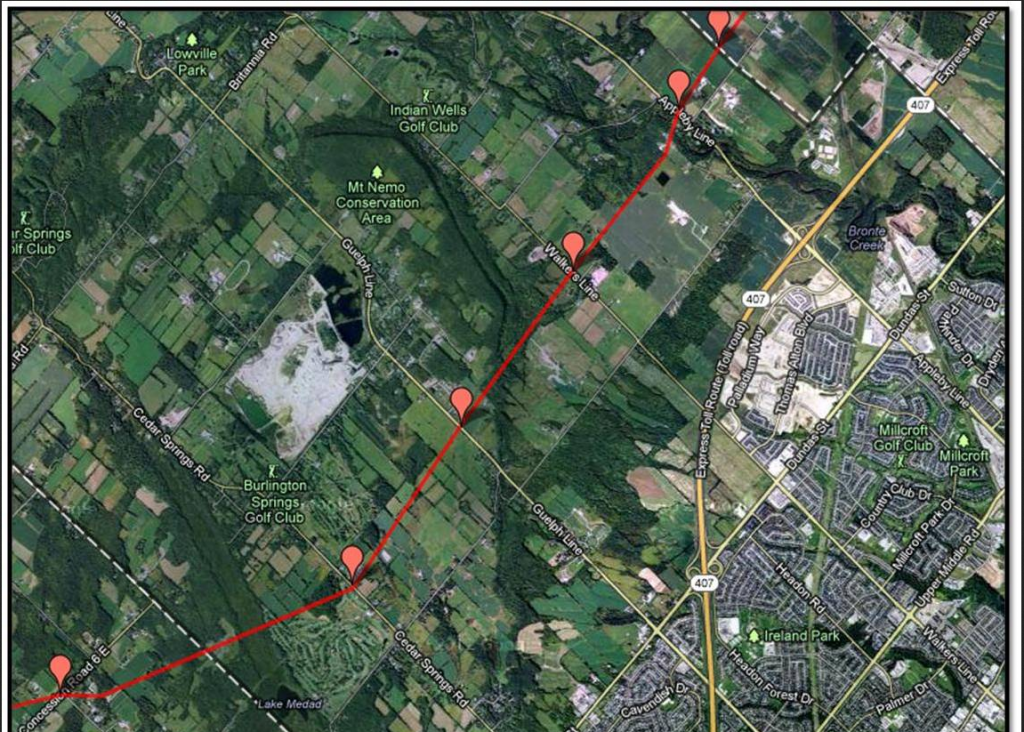 The 407 is about all there is to protect many of the Burlington communities from any oil spill. Residents want to be assured that the pipeline is safe enough to carry dilbit oil and that there are plans in place to handle a spill. The NEB has a policy on who can attend the hearings. People can take part as “interveners” or they can apply to be able to submit a letter. The province has announced that it intends to take part as an “intervener” while the city of Burlington has decided it will submit a letter setting out its concerns.
While submitting a letter might not appear to be very much those letters become part of the record that will be used by the NEB to decide if they will grant the permit Enbridge needs to reverse the flow of the pipeline and transport oil from Alberta.
The NED has not made the process very easy. The application you have to send in to get permission to send a letter runs ten pages long, but it is not as tough as it sounds according to Emily Ferguson, a McMaster University geography student who has been following this issue for some time.
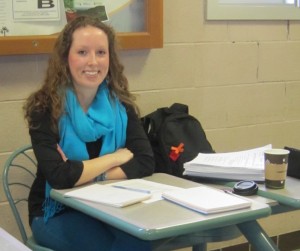 Emily Ferguson, a McMaster University graduate (last exam next week) has been covering the National Energy Board process and the Enbridge Pipeline public hearings for some time. Expect to hear more from her on this subject. Ferguson’s home town is Kingston but her Hamilton residence gives her a look at the bigger picture and she can understand the damage to Burlington and its Escarpment and the potential for serious damage whether that pipe line crosses the Moira River in Belleville and the Cataraqui river or the Ottawa river
Her studies as a geography student certainly don’t hurt either but most effective is the way she digs down a little deeper to see what is happening at the ground level. Ferguson is applying for intervener status and Our Burlington is getting her media credentials so she can cover all the hearings.

 By Pepper Parr By Pepper Parr
BURLINGTON, ON. February 6th, 2013 So what do we think of ourselves and the way we are served by the different levels of government we pay taxes to? Is asking these questions a good way to spend tax dollars? Those are questions you get to ask when you vote next.
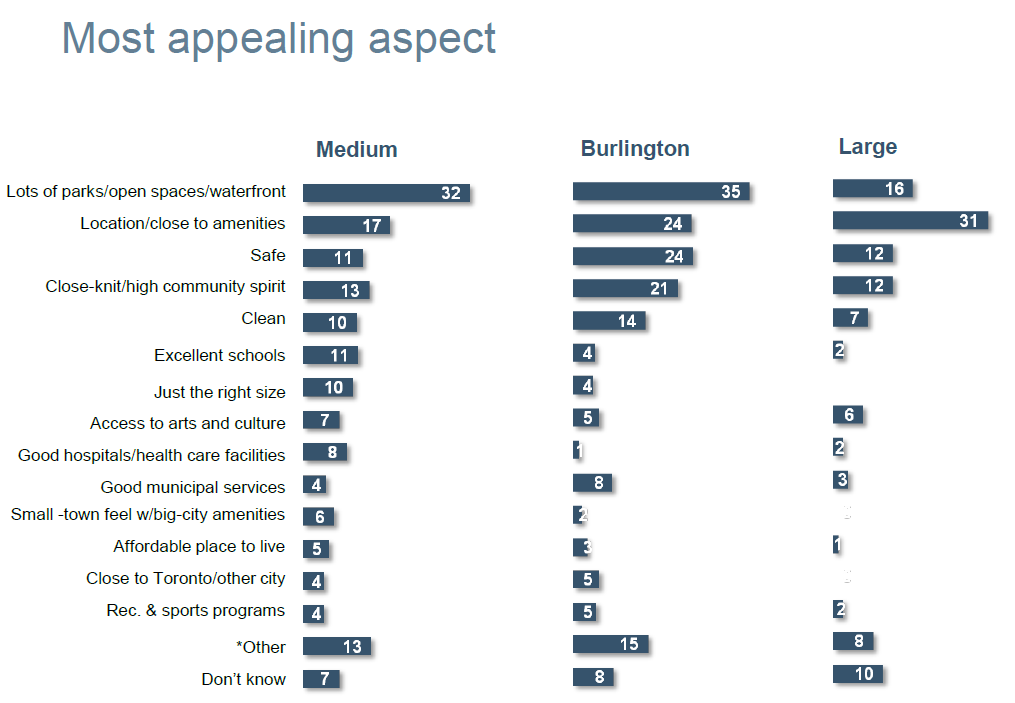 This is a listing of what Burlingtonians see as the most appealing aspects of their city. How much do you agree with these findings? 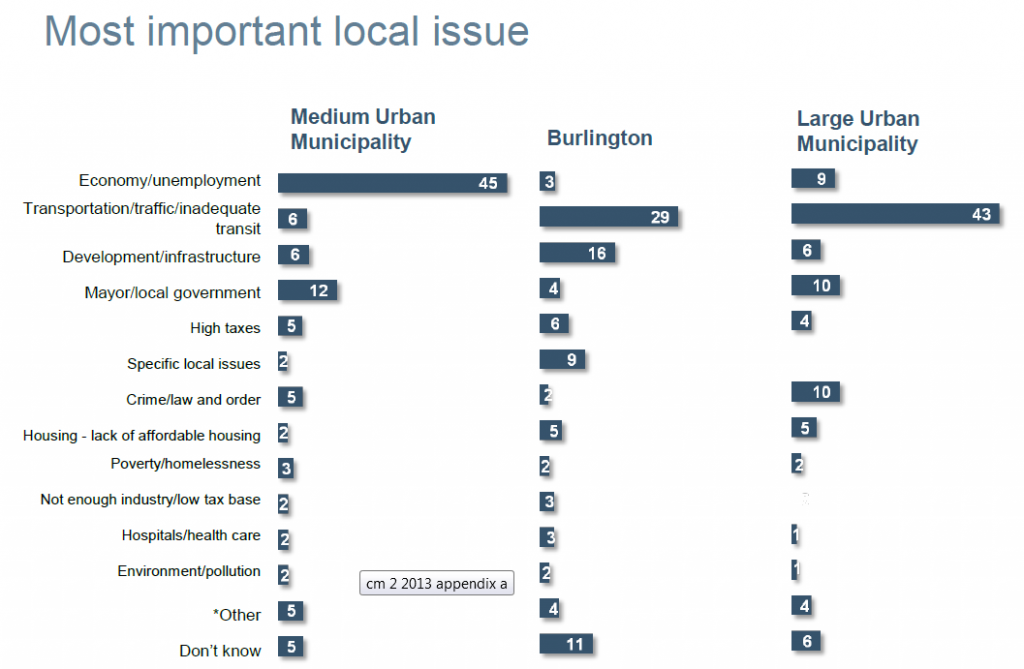 What are the most important issues for Burlington? They are listed here and shown how what is important to us – relates to how important it is to others. We get to see how we are different. Do you agree with what the charts are telling you? 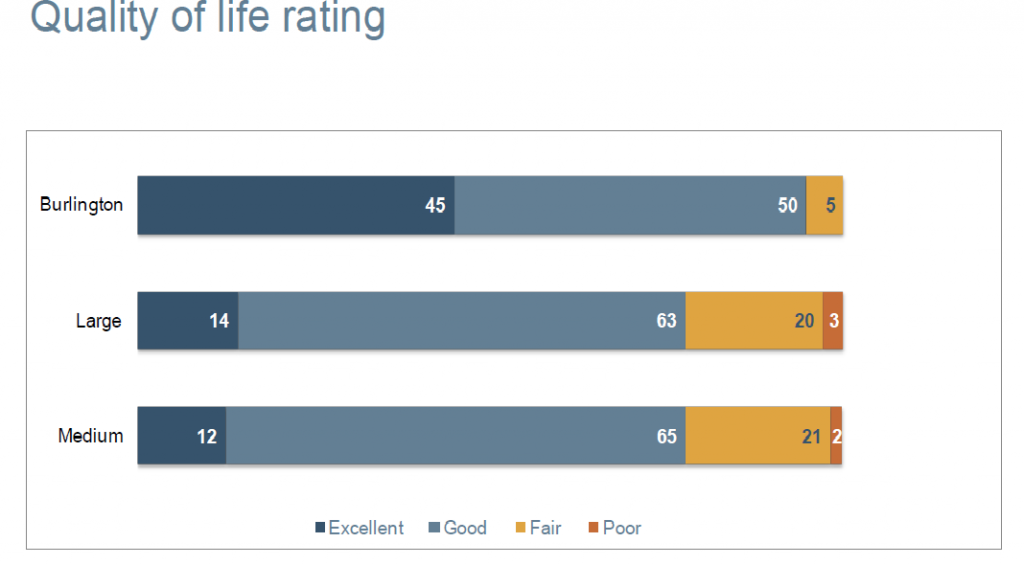 Quality of life: In Burlington the polling sample said they put us at 95% if you include Excellent and Good. Other large and small communities don’t see themselves quite the same way. You just KNOW that this bit of information will replace the very tired and worn – Second best city in the country to live in. 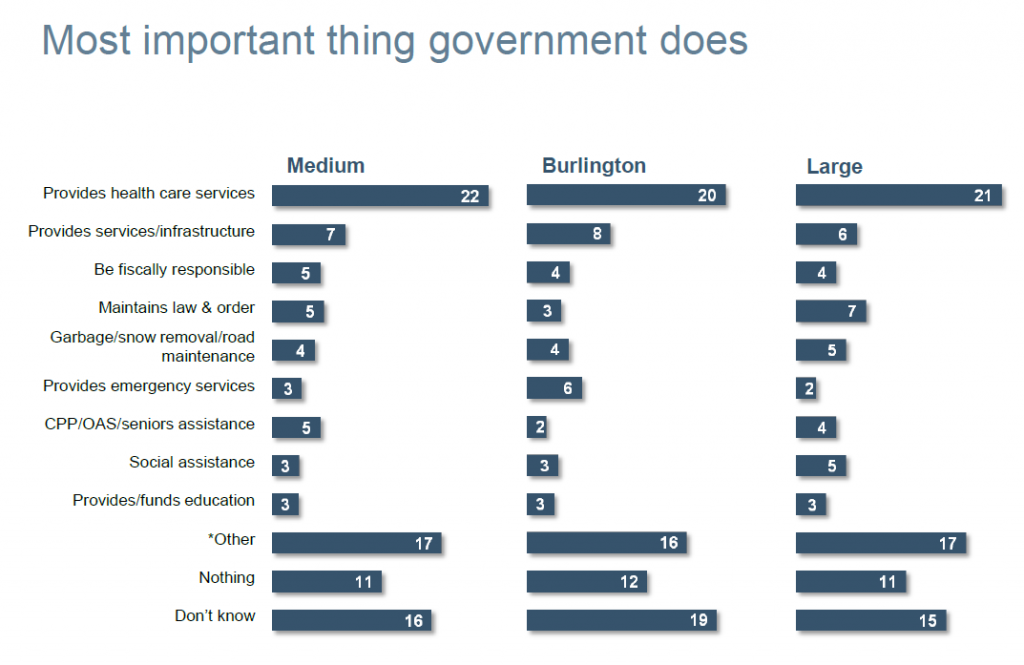 Most important thing the government does for you? There are too many in the “Other” and “Don’t know” categories – suggests the people who pay for the government we have aren’t all that thrilled with what they are getting. For now – look at the questions and the answers. A well-respected Canadian company that has been doing public opinion polling for some time did a poll of Ontario communities both large and small and medium too – asking the same questions of a sample that was just under 400 people.
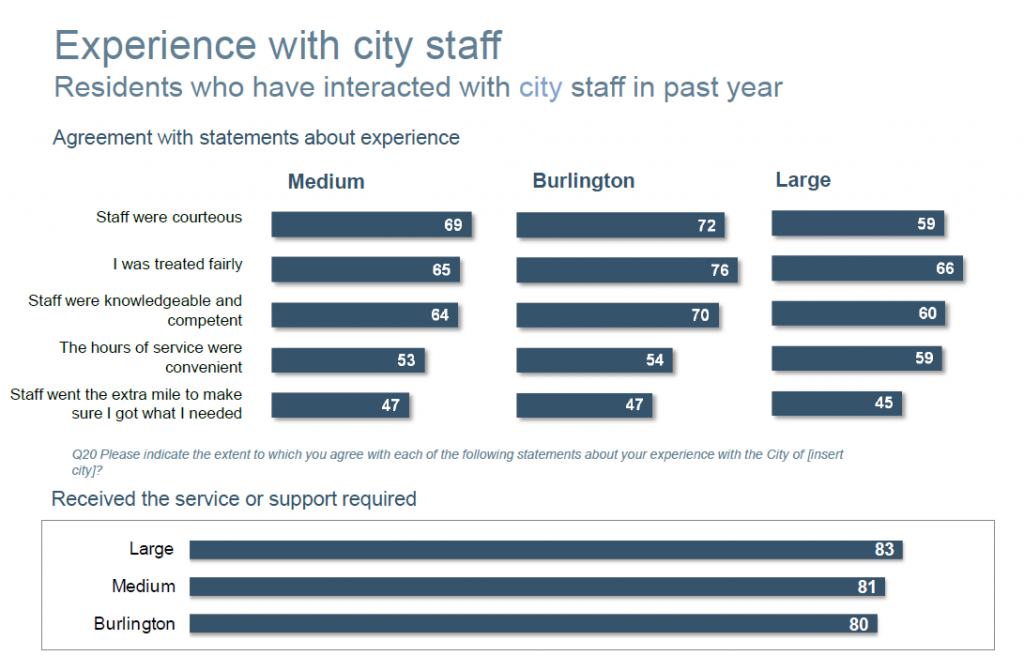 Experience with city staff. Rankings in that “going the extra mile” could be a lot higher; other than that Burlington isn’t that different from the others. 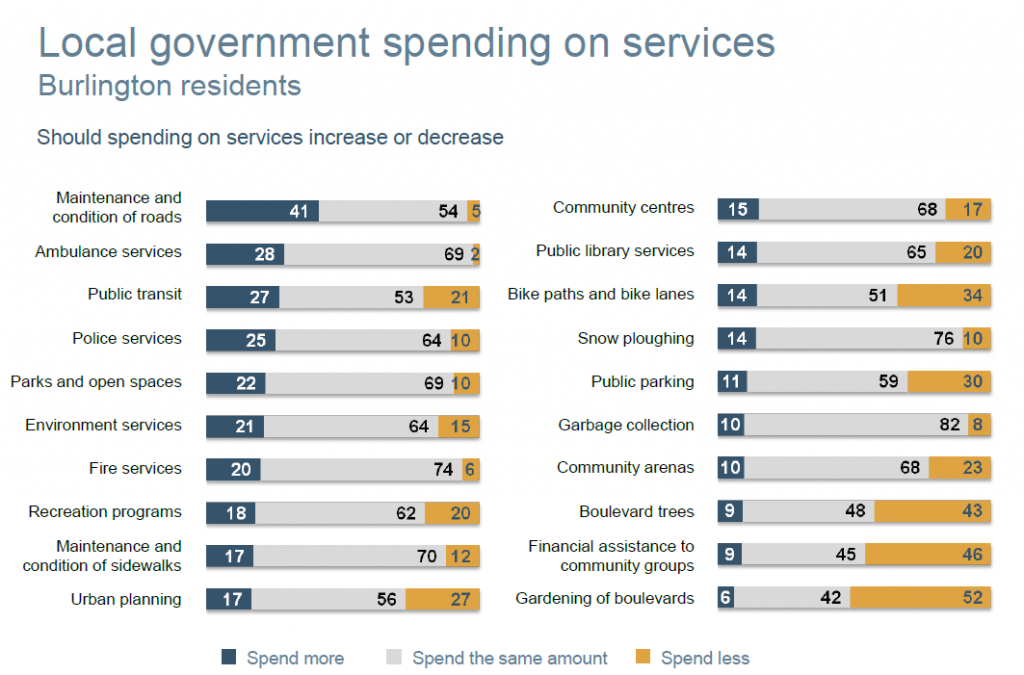 Local government spending – this is where you want your tax dollars spent. Roads are what it is all about – with transit at least being recognized. 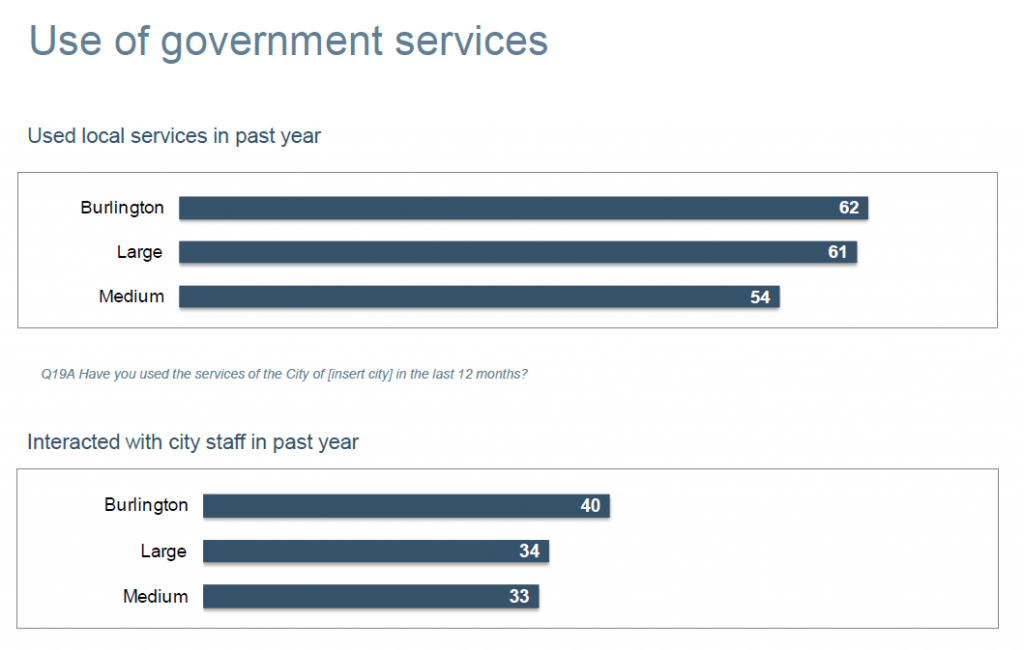 Use of government services: People are using the services government provides and they are talking to staff that don’t go the extra mile. What does that tell us?  Are we getting value for our tax dollars?  If push comes to shove; did you want the city to increase taxes to pay for the services you are getting or would you rather they cut the services. Mayor Goldring interprets this to mean that half of us would accept a tax increase and half us would not. Tough call. 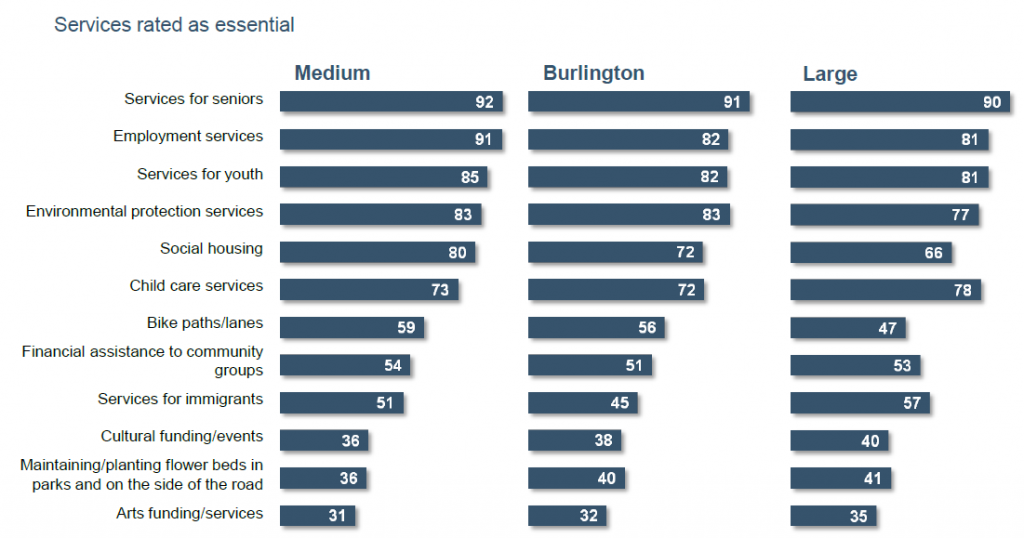 If the city found it had to cut services – this is the list they are likely to work from – it suggests the arts would take the biggest hit. They broke out the individual results for Burlington and for the princely sum of $10,000 you get to learn what we think of ourselves.
 Burlington is where we live but the Region provides very essential services: Garbage pick up, water, sewage and police services as well as social services. The Niagara GTA highway would not have been stopped in its tracks – at least for the time being were it not for solid support from the Region City Manager Jeff Fielding sees that data as an important part of the process of engaging the community.
The results are interesting.
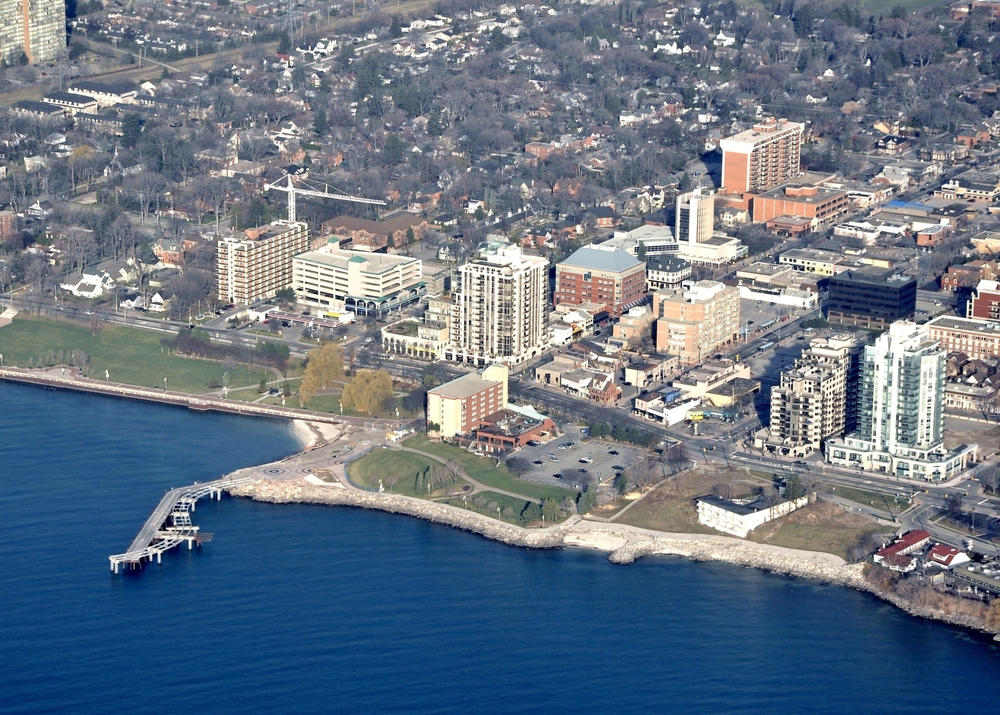 This is YOUR Burlington – do you see it the way the public opinion poll gauges it to be? 
 By Pepper Parr By Pepper Parr
The Halton Region Health Department is launching the first phase of Sex Healthy Halton; a social media campaign to promote safer sex, healthy relationships, raise awareness, and reduce sexually transmitted infections. There is aFacebook page
“The landscape for today’s youth is constantly changing and evolving and we need to ensure the youth are able to get trustworthy, reliable and accurate information and services,” stated Gary Carr, Halton Region Chair. “The Health Department’s approach to service and education is reflecting these changes.”
 Infections transmitted sexually are not just an uninformed teen problem – it`s n adult problem as well. The Facebook page is the first phase. A YouTube channel with videos of Public Health Nurses answering frequently asked questions and discussing current and local topics will be launched later this fall.
In Halton, Chlamydia rates increased 173 per cent between 2001 and 2010. In 2011, a total of 833 Chlamydia cases were reported compared to 454 cases in 2007. Social media and networking sites are quickly gaining popularity as a medium.
And that is all the Region tells you. We researched a bit and have added this:
What is chlamydia?
Chlamydia is a common sexually transmitted disease (STD) caused by a bacterium. Chlamydia can infect both men and women and can cause serious, permanent damage to a woman’s reproductive organs.
How common is chlamydia?
Chlamydia is the most frequently reported bacterial sexually transmitted infection in the United States. In 2011, 1,412,791 cases of chlamydia were reported to CDC from 50 states and the District of Columbia, but an estimated 2.8 million infections occur annually. A large number of cases are not reported because most people with chlamydia do not have symptoms and do not seek testing. Chlamydia is most common among young people. It is estimated that 1 in 15 sexually active females aged 14-19 years has chlamydia.
There is a lot more information the Region could have provided – are we sensing some timidity here?
“There are a lot of false information, myths and misconceptions about sexual health and sexuality,” stated Dr. Bob Nosal, Halton Region Medical Officer of Health. “We hope to provide a safe and trusted environment for youth to ask questions and seek answers. Social media will never replace one-to-one services or counseling, but this will open the door for discussions and education.”
Youth will be able to ask questions (publicly or privately), search for answers, connect with a Public Health Nurse, and find information about clinic locations, times and services.
You can follow-up on this: Dial 311 or call 1-866-442-5866.
There were just 13 likes on the Facebook this morning – we will track this and see if it is serving a useful purpose or if it is just one of those mickey mouse, tepid efforts that bureaucrats who don’t want to embarrass anyone tend to do.
A mistake made as a teenager alters a life forever and usually not just the life of the teen. Kids get it – we just need to inform them. This just might be one of the good ideas.

 By Pepper Parr By Pepper Parr
BURLINGTON, ON. January 16, 2013 While the part of Lakeshore Road that has the heavy traffic, and on which the city wants to paint lanes for exclusive bicycle use, is not in Ward 1, Councillor Craven assured a Workshop talking about how to better engage the community, – that there will be letters galore on how stupid an idea bike lanes on Lakeshore is. A view we must add which the Councillor does not share.
The different views on bike lanes on Lakeshore Road got trotted out at a four-hour meeting Monday evening at which council heard 12 delegations that basically broke into two camps – those who believe fervently that we will be healthier and the environment will survive if we can get cars off the road and those that believe they have the right to make left hand turns off Lakeshore into their driveways.
Issues like this are the bane of every politician – they can’t win. At least half of their constituents are going to be unhappy. This is the time when the politicians have to rise above their local interests and go for the better good. And on Monday night – they, for the most part, did just that.
It would have been one of those 4-3 votes that used to plague Burlington but with Councillor Taylor away it came in at 4-2 with Councillors Meed Ward and Sharman voting against the six to nine month pilot project city staff has proposed.
While there were solid arguments from intelligent people on both sides what was evident was the split in thinking. Great idea said Councillor Meed Ward – just not on Lakeshore Road,
 Ward 4 Councillor Jack Dennison, the only one without a helmet, doesn’t that tell you something, is an avid cyclist who has put his money where his mouth is. His popularity will be tested when the lines get painted on Lakeshore Road. Jack Dennison, who lives on Lakeshore Road and is the Councillor for that part of the city explained very carefully that this was just a pilot project, but the intention is to eventually provide bike lanes for the full length of Lakeshore Road – from the canal on the west end all the way to the Oakville border.
The cyclists and the environmentalists believe the time has come to take serious steps to lessen car use and Monday evening they got past the first hurdle. Council committee instructed the Director of Transportation Services to conduct a trial re-marking of Lakeshore Road between east of Seneca Avenue and Guelph Line to provide on the road bike lanes and to report back to Council in the Spring of 2014 on the results of the pilot.
There are some complications in that the Region is digging up part of the road and exactly when that work will be completed isn’t certain. When you dig a hole in the ground to get at a water pipe – you never know what you are going to run up against – so timing gets a little iffy.
Some of the residents along Lakeshore brought good arguments to the table – but nothing they said was reason enough not to do a pilot. Right now all we have are a lot of strong feelings on both sides. Some data will help.
The city ran into the same problem when it put in the bicycle lanes on Walkers Line and Appleby Line south of New Street. The world was going to end – but it didn’t. There haven’t been any problems – however, there hasn’t been a huge increase in bicycle use along those stretches of road either.
Does it need more time for the city to know if the Appleby and Walkers bike lanes were a good idea that is being used by citizens? Probably too early to tell and it will take some time to learn if the volume of traffic on Lakeshore Road can accommodate bike lanes on the north and south side of the road, and if it is truly safe as well?
The cyclists believe it can be made safe while the people who live along the road or adjacent to it can only see long lines of cars backed up while someone waits to make the left hand turn into the street they live on or their driveway.
Jim Barnett, who lives on Shoreacres said that he has faced occasions where he has had to wait for more than five minutes before there was a chance to gun his engine and slip across the oncoming traffic. Dr. Margarett Ackerman spoke for herself and a number of residents and said that it was always very difficult to make the left hand turn into her hone when she was returning from the Joseph Brant Memorial Hospital where she is an emergency surgeon and told of a situation when an obstetrician was not able to get to the hospital on time to handle a delivery.
Mention was made of back-ups that are 50 cars in length that sit waiting for the person at the front of the line to be able to make that left hand turn.
There were exaggerations all over the place. Ken Love, the first person to speak spoke of the damage that cars do to our individual health and the environment; but what he had to say and his bombastic approach was so far over the top that he didn’t do much to advance the argument for adding bike lanes anywhere in the city.
 One of the few occasions you will see Councillor Meed Ward or Mayor Goldring on a bike. Councillor Dennison bikes, roller blades – big on physical stuff. Photo op promoting the two Car Free Sundays Burlington held in 2012 Councillor Sharman spoke of his concern for some of his elderly residents in Ward 5, who might die while in an ambulance that got tied up in traffic.
Meed Ward said bike lanes were a good idea – just not on Lakeshore Road. New Street or Fairview was her choice for bike lanes. Meed Ward does not use a bicycle.
It was hard to tell, while listening to the delegations, which way this council was going to vote. The Mayor will usually always side with the environmentalists – but you only see him on a bike during a photo-op.
Councillor Craven surprised us when he voted for the pilot project as did Councillor Lancaster when she voted to try it. Lancaster tends to identify with the hard-core Tory crowd along the Lakeshore and doesn’t usually go out on a limb. Her vote was the one that made the difference. Councillor Taylor was not able to attend the council committee but made it known that he did not support the pilot.
Dennison, a very active cyclist, takes the view that car drivers do not own the road – the road is there to be shared by cyclists and car drivers.
The bicycle crowd put forward some pretty solid data and they brought forward enough good argument to make the trial worth talking a chance on.
The issue for the cyclists is “quality of life”. They know that Burlington is not going to be like our sister city Apeldoorn, in Holland, where a very large part of the population does not use or own a vehicle – Apeldoorn is basically the same size as Burlington and about as far away from Amsterdam as we are from Toronto.
The Dutch will be in Burlington sometime in the not too distant future to open up a commemorative park – might be a good idea to put them all on bicycles and listen to what they have to say about bicycle use in a municipal setting.
The cyclists believe that if you build it they will come. Which is just what the Lakeshore resident fear – that the cyclists will come and muck up the flow of traffic, making it worse than it is now.
“If you add bike lanes more people bike; cyclists go out of their way to use bike lanes.” That kind of statement sends shudders along the spines of those who live along the Lakeshore.
“We are all much healthier if we bike and get the exercise we need,” say the cyclists. “We agree” say the Lakeshore residents “and the city has all kinds of bike trails where you can do just that”.
 Who uses a bike in Burlington? There are the Strong and fearless (1%) – you see them on the road in the middle of winter. There are the enthused and confident; people who use their bikes frequently and would like to use them more – 5-10% of the cycle crowd. Then there are the no way, no how people, you will never see them on a bike, they make up 30% of the demographic. It is the 60% who are interested in using a bike but concerned about their personal safety. This is the target market and these are the people the cycling committees want to see on Lakeshore Road. The bike people want less hysteria, more facts and measurements. They would like to see the left hand delays measured; they want to know just how many bike car accidents there have been as well. During the Council committee the audience was told that there had been four accidents involving bikes over the last four years in the stretch of the road where the pilot is to take place.
Councillor Sharman, who is strong on data, gave Vito Tolone, one of the city’s traffic experts, a very tough time over the lack of data. Tolone didn’t deserve the punching around he got; there was no need to manage him quite as aggressively. It’s an approach Sharman chooses frequently – one hopes that when the data is available he will make good use of it and not exploit it shamelessly to convince his constituents that he is doing a good job on their on their behalf.
Lakeshore Road is between 9.6 and 9.75 metres wide from Seneca to Guelph Line. It widens to more than 10 metres east of Guelph.
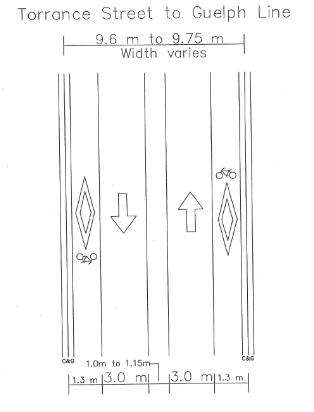 The pilot will run from SENECA, not Torrance, east to Guelph Line. The pilot plan is to reconfigure the road and mark it so that there is a bike lane on each side that will measure 1.3 metres in width. There will be two traffic lanes 3 metres in width. These two traffic lanes will be separated by a lane – NOT a turning lane – that will be between 1 and 1.15 metres wide. It is a lane that cars can edge into when they want to make a left hand turn.
Can it work? We won’t know until we try. Will traffic still back up? Of course, we’ve done nothing to decrease the amount of traffic on the road. That’s a traffic engineering problem; a traffic management task – bicycles are not going to make a difference to the number of cars on the road. The proposed plan will reduce that turning lane and that might result in a line of cars building up behind the car that is trying to make the left hand turn. If the turning lane were made 5 metres wide – it still would not change the volume of traffic nor would it allow cars to make left hand turns any faster.
Those arguing against the creation of dedicated bicycle lanes are not looking at the bigger picture – which is to reduce the number of cars on the road.
The bicycle people argue that the world has changed in 20 years and that the youth of today are not jumping into cars the way previous generations did. They point to a study that has younger people not buying cars and that demand will be down by 2 million units a year.
They point to data that has the percentage of 20-to-24-year-olds with driver’s licenses at 92 % in 1983 but currently at 81%; that could well be because this demographic can’t get jobs and have too much student debt to manage –but the fact appears to be that there are more younger people who have chosen not to drive a car.
The right decision, say the cyclists, is to widen Lakeshore Road – that option has a $9 + million price tag attached to it – which is half what the pier is going to cost us.
The next best, from the cyclists point of view, is to add segregated bike lanes to the existing road.
Burlington created two Car Free Sundays last year. The one on Appleby Line was successful but the one on Brant Street was close to a disaster.
Nevertheless, there is a core commitment on the part of this city council to get more people on their bikes. The pilot made it past the council committee stage. Council member phones will be ringing; the emails will flood the in boxes of every council member. Will they stand their ground or will they buckle – they are politicians. The ones to watch are the Mayor and Councillor Lancaster. We just may see what they are really made of.
Why is traffic on Lakeshore such a mess? Where do the cars come from and is there anything that can be done to divert traffic? If one wonders what traffic on the QEW is like all you have to do is check out the flow along Lakeshore. When the QEW is basically “stop and go” in spurts at that – traffic will cut south to Lakeshore where there is at least some movement. Is there some way to keep the traffic on the QEW and prevent it from drifting south the Lakeshore? That’s something traffic engineers have to work out.
 Concrete poured when the road was upgraded in the mid ’30’s. Known then as The King’s Highway it was THE route from Toronto to Niagara Falls. Lakeshore Road was originally known as the King’s Highway – Hwy #2 to many people. Construction began in 1917. In the mid 30’s the road went through a significant re-build. It is now a nice easy road through perhaps 50 communities between Windsor and Gananoque.
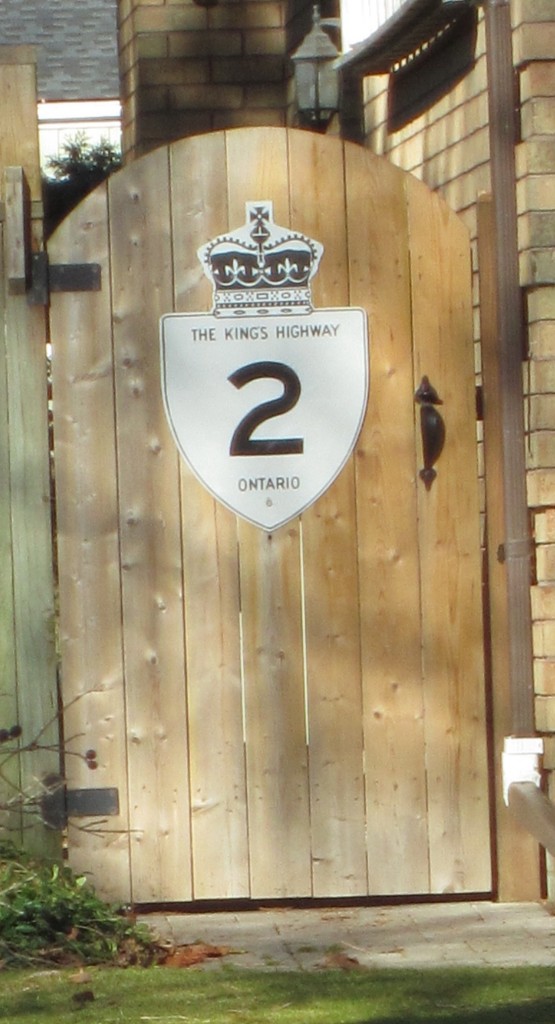 The old Highway name is now a decorative item for one of the homes along Lakeshore Road. What it becomes in the next 25 years will be at least as interesting as the last 25 years. It’s no longer a major highway. It many small towns it runs along the main street; in places like Burlington it is a road that could, if we let it meander along the edge of the lake where some magnificent homes have been built. It’s a wonderful drive through smaller, picturesque communities. We seem to have forgotten that in Burlington and see it as a road we should be able to zip along and at the same time treat as a street where we can turn into our driveway and not have to wait more than 10 seconds.
Change does not come about easily. For years most of us smoked; for years many of us never used the seat belt and for the longest time we felt it was OK to “have one for the road” and got behind the wheel of our cars when we really weren’t able to drive safely.
Times changed. Gas was cheap, we lived in sprawling suburbs where a car was vital – and they were fun to drive. You came of age when you had a car and the open road was all yours.
Now we are aging. For many that are in their 60’s their night-time vision isn’t what it used to be. Most of us know that there will come a time when our family doctors will have to tell the government we should not have a license. But we will be able to ride our bicycles for those small errands –and city council wants to have those safe cycle paths or lanes in place for that close upon us aging society to use.
Rob Narejko spoke to the Council committee as Chair of the Cycling Committee and said the information he was using was factual, with references to studies from accredited universities, government agencies who specialize in health and transportation. “You know my delegations are generally short and to the point”, said Narejko, “I regret, for both of us,” he added “that today’s delegation is much longer.”
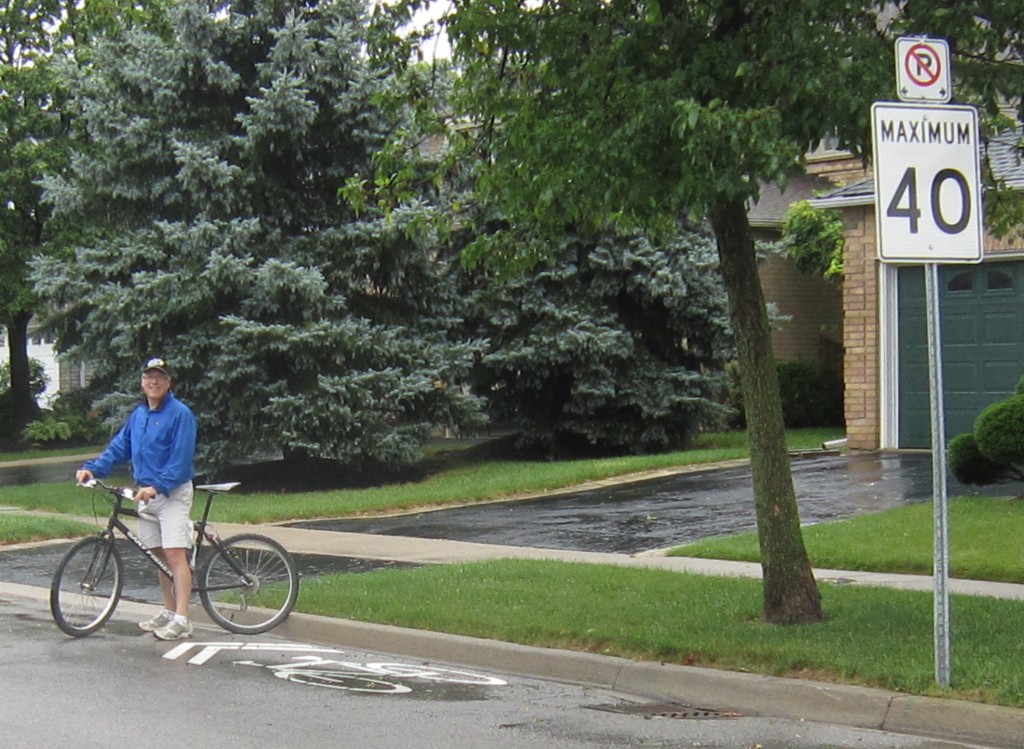 For Rob Narejko – this is the only way to go – slow speeds and roads with bike lanes. It is what he considers a quality life style. He drives a car as well. To put his remarks in context Narejko mentioned the value of strategy for continued viability of the City, the value of an active lifestyle and the value of the lines on the road.
“Nothing fails like success”, a quote attributed to many people and used by Narejko to show people have become comfortable with the way life is now. “They forget the work and tough decisions that got the city to where it is now and become complacent. The city gets stagnant, unable to attract business investment. Taxes rise, residents become disgruntled and before long, a once prosperous city is in decline” said Narejko.
Many people believe Burlington is a success. In this snapshot in time, it definitely is. But there are signs that show we are not keeping up.
Narejko pointed out that “Cars are a significant part of our city because we have designed our cities around the car. Cars are definitely needed as a method of transportation, due to the design of the city; just under 80% of people use their car for their daily trip to work.”
 If it’s about “quality of life” this is probably what they are talking about. The Car Free Sunday on Appleby Line south of Fairview. One part of the city’s longer range project to get people using their bikes. “A city is about people: says Narejko. “People make the city work, not cars. Bikes, walking, public areas, green spaces are about people. It takes a crisis for most people to adopt change. Smart leaders don’t wait for a crisis. They create a vibrant plan for the future, through consultation with experts and the general public and then they carry through on that plan. If you don’t act on the plan, why go through the effort of creating them, taking up people’s time, spending money on experts and then shelving the reports? Do you want to be known as Councillors who kick the can down the road for the next Council to deal with when we are deep in trouble? Or do you want to be known as leaders who guided the City to the next level?
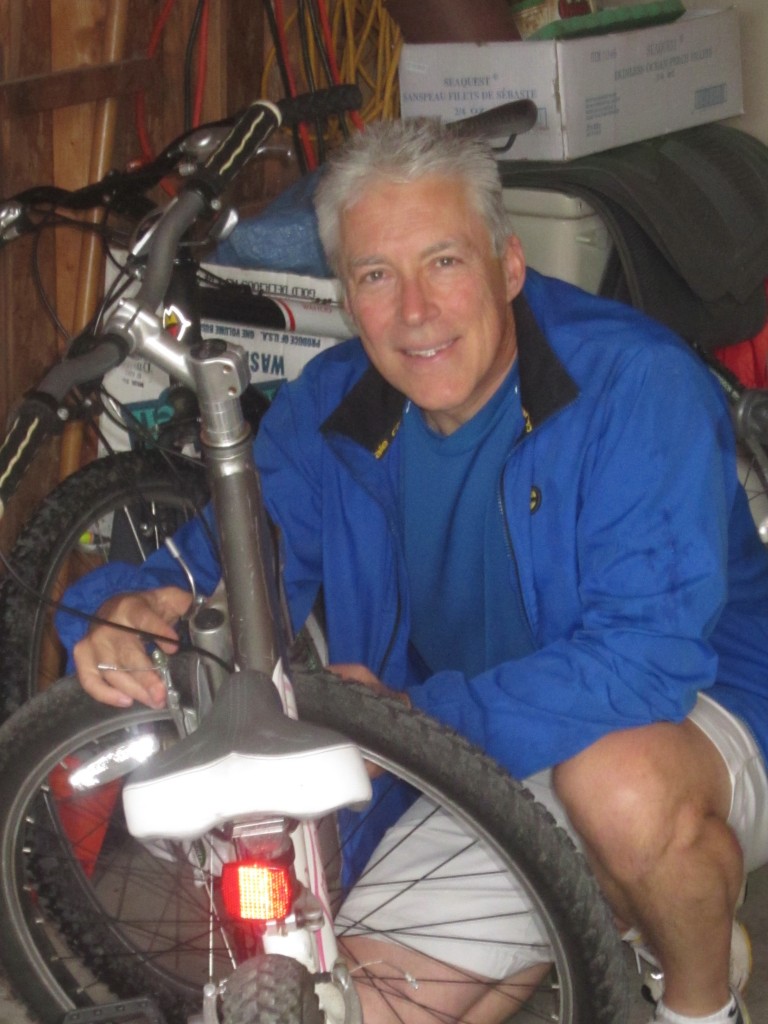 Rob Narejko, Chair of the City’s Cycling Committee rides a bike, a motorcycle and drives a car. Does he ever take the bus? Rob Narejko maintains that Council was not elected to maintain the status quo. He isn’t going to get the level of agreement he expects with that argument – there are many, perhaps most people, in Burlington who are quite happy with the way things are – and they don’t want much in the way of change.
“Look at this issue” implores Narejko: “look at Guelph Line, Brant St, Walkers’ Line, Appleby line where changes were made: It is amazing to me how much people complain about minimal, positive change prior to it coming and then where do they go afterwards? Not a peep.”
“Has there been any negative feedback from any of the Guelph, Walker’s or Appleby projects? To my knowledge, gathered from City staff, no there have not.”
One of the dumber ideas Narejko suggested was that if traffic commute time is a priority on Lakeshore Road, then the city should pass a by-law that would permit only cars that belong to, and are driven by Lakeshore residents between the hours of 5:00 and 6:00 PM, Monday to Fridays. Narejko, who normally has useful argument, might want to pull that one.
Cycling, Narejko pointed out, is an accepted, legal and critical mode of transportation in all cities in all countries around the globe. He added that he could hear the nay-sayers piping up with: ‘yes, but not in Burlington’
Narejko and his colleagues point out that there are strategies developed by expert and rigorous processes to guide thinking at all levels of government which Burlington Council seems to ignore. There are five provincial initiatives (Places to Grow, Big Move, Strategic Cycling Plan (draft), Healthy Eating Active Living, Complete Streets) either in place or being developed as well as two Regional initiatives (Active Transportation Master Plan (under way), Active Halton) and then the city’s Cycling Master Plan and the Strategic Plan.
“It is very frustrating as an invested citizen in this community” said Narejko, “to have to fight for what should logically be done based on strategies and advice already in place.”
This initiative did get past a Council committee – all it has to do now is get through Council at the end of the month – without another dozen delegations please, and let’s get on with the six to nine month trial and see what the data tells us.
But it isn’t going to be quite that easy – is it?

 By Staff By Staff
BURLINGTON, ON December 5, 2012 The city has plans to help you keep your kids active, engaged and entertained this winter break with camps and programs for children and teens.
The programs run from December 27, 2012 to Jan. 4, 2013.
There are many activities to choose from:
 If we get some snow – the kids just might be able to enjoy a Canadian winter – before Christmas? Holiday Drop-In Family Gym – Drop by the gym and enjoy active time with your child
Festive Fun – Four days of seasonal crafts, songs and activities for your preschooler to enjoy
Holiday Mini Blast – Let your child use their imagination – games, crafts and much more!
Holiday Junior Blast Daily swimming, gym time, outdoor activities, crafts and more
 No snow? There are always swimming pools. Check out the available programs and register for a spot. Holiday Junior Blast – Special guests, daily swimming, active gym time and more
Holiday Outdoor Opportunity Blast – Creative and fun program for teens with disabilities – special guests, daily swimming, active gym time and much more
Extended Care Holiday Blast – Extended Care is available for all Tansley Woods Holiday Blast programs
Youth, eight to 16 years, old looking for programs offered in the city can choose between:
Holiday Tripper Blast – Trips every day: laser tag, movies, rock climbing and an indoor water park
Home Alone – Prepares children to stay home alone or with a sibling for a short period of time
Babysitters’ Training – Youth will be trained in childcare, child development, safety, their rights and responsibilities and more
To register, call 905-335-3131 or visit www.burlington.ca/recexpress.
The full list of the City of Burlington’s activities during the Winter Break.

 By Staff By Staff
BURLINGTON, ON December 4, 2012 If you’ve ever wondered what meditation is; what a Yoga class is really like but you don’t want to join anything – you just want to sit in and see if there is something there for you – then an event this Saturday, December 8 from 3-5 pm at the Brant Hills Community Centre may be of interest.
If you do go – what are you in for?
 Here is what is on the agenda: Here is what is on the agenda:
There will be a talk by two academics on the Restorative Effects of Sahaja Meditation techniques. There will be testimonials, some guided mediation, live music and Indian Kuchipudi dance
The group putting on the event has been doing this for more than seven years in Burlington.
Their Sahaja meditation classes take place Wednesday evenings at Brant Hills.
The event this Saturday will be tied into an event taking place in Paris, France.
Mediation and Yoga are different, millions swear by it, but it isn’t for everybody – it’s a matter of personal taste and the way you feel life should be lived. If you’re curious – give it a try.
More on the agenda:
A video introduction to Self-Realization & R/Evolution (video)
Experience Spontaneous Meditation & ‘Yoga State’ on Live Indian Drum Music (Ahilan)
Kuchipudi Dance Performance (Hema)
Chakra Workshop & Joyful Indian Music Performance
Practitioners of meditation will talk about the benefits.
You get a chance to find your “Yogi Buddy”.
The event is free – these people are serious and committed about what they do.

 By Pepper Parr By Pepper Parr
BURLINGTON, ON December 1, 2012 The United Way campaign for Burlington and Greater Hamilton has reached that first wonderful number of 50% – at least for those on the other side of the Bay. Half way is a nice place to be with any objective and the Hamilton crew is doing very well.
Burlington does have a bit of catch up to do – they are at 50 % of their $2.1 million target.
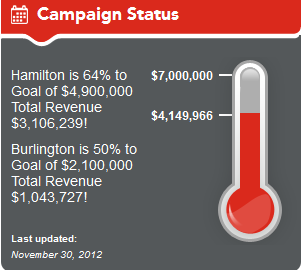 Combined Burlington and Hamilton are at 50% of the 2012 goal of $7.1 million. Combined Burlington and Hamilton are at 50% of the 2012 goal of $7.1 million.
Paddy Torsney assures us that the lower Burlington number is due to the slower start of the campaigns at some companies – “start later/numbers come in later”, commented Torsney who is more than confident that the Burlington target will not only be reached but exceeded.
Torsney plans to exceed the $2.1 million that was to come from the Burlington community. That is going to mean an extra push but if the Christmas decorations on Burlington homes are any indication as to where the economy is going – then there are dollars in those pockets that could make their way to the United Way.
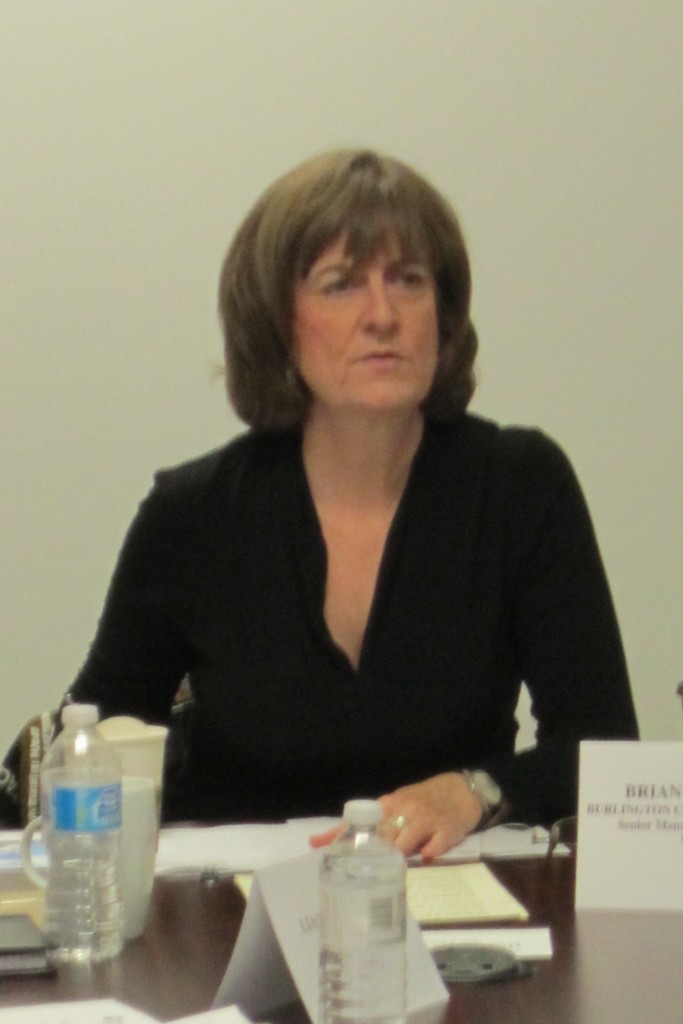 Chair of the Burlington side of the Burlington/Greater Hamilton United Way campaign Paddy Torsney frowns when she sees the total for Burlington’s $2.1 target being at just the 50% point. She wants to exceed her target. “We are seeing an increased demand for services that is putting incredible pressure on our programs,” said the Hon. Paddy Torsney, 2012 Burlington United Way Campaign Chair. “Many of these programs rely on United Way funding, which means now more than ever we need our citizens to step forward and support the United Way campaign. We have people in this community facing homelessness, children going to school hungry, seniors in isolation and families in crisis. If individuals and businesses in Burlington and Hamilton donate today, we can reach our goal and we can provide the vital funding necessary to help people in-need, right here in our community.”
There is still time to donate and it has never been easier. Visit the United Way website where you can donate online, or contact the United Way by phone (905-527-4543 or 905-635-3138) if you would like more information on donating in person, through your workplace or at the leadership level.
The funds raised by the United Way of Burlington & Greater Hamilton support 131 programs and services in the community, assisting seniors, individuals, families and children in-need – many of whom live below the poverty line.
Bringing the money in is a large part of the job; figuring out where it should go is another part of what United Way does. The organization itself doesn’t run programs – it funds agencies that run program in each community.
One of the more innovative programs that has been around for some time is the Halton Food for Thought program It has been operational for more than 15 years. Their focus is ensuring that students in school do not go hungry.
Ask anyone who works for or volunteers with an organization committed to helping feed those in need and they will tell you the same thing: people simply don’t realize the level of poverty and hunger in Halton Region, and even if they do, they don’t appreciate how many children are affected.
Ask Gayle Cruickshank, Executive Director of Halton Food for Thought, if there is a hunger issue with children and she’ll let the statistics speak for themselves: Halton Food for Thought runs 146 food programs at 104 different schools; there are 16,000 students in need; and they serve two million meals every school year. Depending on the neighbourhood, somewhere between five and twenty-five per cent of children go to school hungry.
With that enormous challenge at hand, Cruickshank is extremely grateful to the many partnerships she has developed, including a very important one with ReFresh Foods and Food for Life.
We talked with Gayle Cruikshank a few days before her AGM and got some of the background on just what Food for Thought does and how it interacts with the United Way. Food for Thought is one of the many not-for-profit organizations that receives funding from the United Way. They receive just 11% of their funding from threeUnitedWays. Or if you want just Burlington it is 7%
Getting a number of Food Trucks to congregate in the one place was a really brilliant idea that Food for Thoughtusedto raise funds with other agencies for the United Way
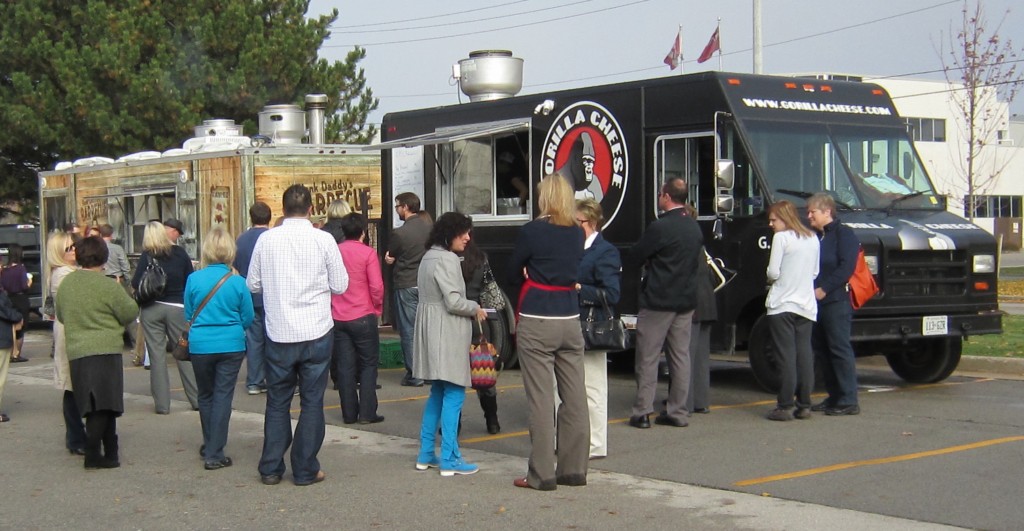 Getting a number of Food Trucks to congregate in the one place was a really brilliant idea that Food for Thought used to raise funds but also to tell the United Way story. They have to raise the rest of the money themselves which at times means getting creative. Cruikshank came up with the idea of arranging for a number of Food Trucks to congregate at the one location in the commercial/industrial part of the city where there are few places to get a quick lunch. She convinced the Cup cake Diner, Gorilla Cheese and HankDaddy BBQ to show at a parking lot on Harvester Road outside the Burlington United Way office. . To everyone’s surprise and delight – the Cup cake truck sold out in less than half an hour while the other two had line up sixty people long. Expect to see more of that kind of fund raising next year. Food for Thought raised $800 with the one Food Truck event; enough to feed five students for one year.
While ensuring that a student is properly fed is vital – it’s a bit more than just feeding them. It’s an opportunity to teach students solid nutritional lessons and to form up the link between the Public Health nurses and the social workers.
While ensuring that a student is properly fed is vital – it’s a bit more than just feeding them. It’s an opportunity to teach students solid nutritional lessons and to form up the link between the Public Health nurses and the social workers.
Students that aren’t eating properly usually have social and or health issues. Add to that. The shame that some feel when they need help getting by. These students often live in assisted housing and have just the one parent in the house. The pattern is the same time and again. Hard for the student and depressing for the Food for Thought volunteers because they know the cycle can be broken.
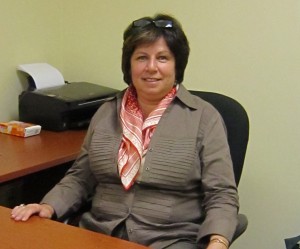 Gayle Cruikshank got her first look at Food for Thought in 1997 Cruikshank’s first look at Food for Thought was when she attended an event at her daughter’s elementary school in 1997 when Darlene Edmonds was running the program. It didn’t take long for something to happen: Cruikshank was invited to sit on an Advisory Board and that led to her taking over the running of the organization when Edmonds moved on in 2001.
The focus then, and still very much the focus now was to ensure that every student was eating nutritious meals every school day. The link between decently fed students and good grades plus good social behaviour is what justifies everything Cruikshank and those running the Food for Thought program do each day.
It costs about $180 per student per school year to ensure they are fed through a healthy breakfast.
At their AGM, held at Robert Bateman high school where Murray Zehr did the honours and got things set up. The Food for Thought team was on hand which included: Carrie Baillie, Oakville Program Manager; Julie Bertoia, Burlington Program Manager; Chantal Ingram, Director of Programs; Maureen McLaughlin, Halton North Program Manager; Maria Moutsatsos, Edible Garden Coordinator and Kelly Stronach, Manager of Program Development
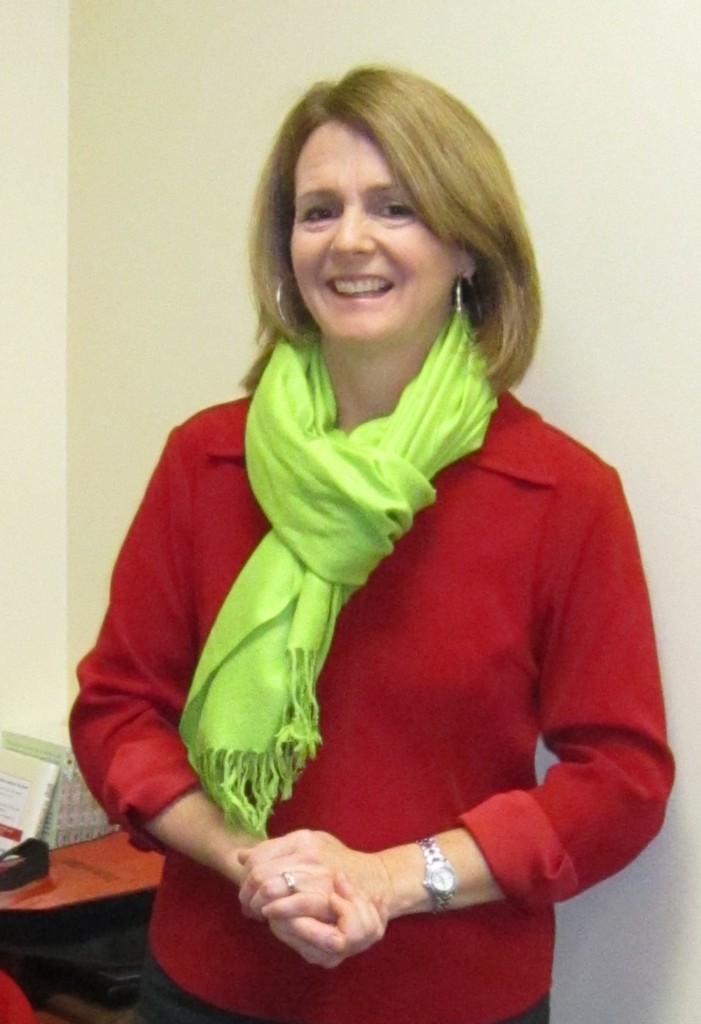 Kelly Stronach , Manager of Program Development works closely with Gayle Cruikshank, Executive Director of the not for profit Food for Thought. During 2012 the organization started ten new programs while 17 schools increased service days to ensure students had access to healthy foods every day. They expanded their Farm to school program to 13 schools involved and started five new edible school gardens. It was a busy year.
“G”, a student who participates in the meal card program sent in her thanks for the help she gets. Properly fed she has seen an improvement in her concentration and thus her academic performance. She will graduate with enough credits to continue her education.
“M” also sent his thanks. His teacher had said there were behavioural issues. “M” used to go home for lunch often eating only a pop tart. Since the healthy snack program started he has been enjoying the healthy food and behaving much better. He now stays at school for lunch instead of eating at home alone, his social skills have also improved.
A 16 year old student who had been referred to the social worker at high school for continually skipping classes and at times missing full days of school. The social worker discovered that he was parented by a single mom, lives in low income housing, and was diagnosed ADHD and depression. After much discussion about future goals the student and the social worker talked about engaging him in a co-op placement to gain work experience.
The student was given meal cards to ensure he was having at least one meal a day. When asked to fill in the career ideas booklet he placed very high in create arts and because he enjoys food so much he did the coop in the school cafeteria which he enjoyed immensely. He attended this placement daily without fail and was seen in the cafeteria preparing delicious lunches for students and staff. He has applied to the Culinary Skills, Chef Training – at George Brown College.
 Gayle Cruikshank, Executive Director, seated and Kelly Stronach, Manager of Program Development: two of the seven member team that make Food for Thought work day in and day out as one of the United Way funded agencies in Burlington. These are just three stories from the hundreds of schools involved; these are stories of United Way funds supporting local agencies deliver support where it is needed.
This is an organization that serves us all and especially those students who don’t have the support most of us grew up with. Gayle Cruikshank and her team of volunteers do that work on your behalf – let’s continue to make sure they have the funds they need – at this point Burlington is at the half way point to a very modest goal.
The theme the United Way works under is: Change Starts Here. That could be your loose change; see what you’ve got in your pocket right now and commit to giving that each week throughout the year.
Beth Deazeley, Neil Oliver, and Patty Pelekis joined the Food for Thought Board of Directors this year for two year terms. They join Maria Nancy Thornton, Chair; Cheri Chevalier, Vice Chair; Nicki Glowacki, Treasurer; Margaret Maronese, Chris McNamara, Jessica MacKay, Reg Farnand and Phil Simeon.

 By Pepper Parr By Pepper Parr
BURLINGTON, ON November 22, 2012 The United Way campaign isn’t going to go away – unless of course, we go right over the top and reach the $2.1 million Burlington target. But if we do that – you know what’s going to happen: Paddy Torsney will want to set a new record for the city. This is a very competitive woman.
The next opportunity to be part of a campaign that is easy for those of us that have a decent job, live in a secure setting and are amongst people who love and care for us; we are able to contribute. There is an electronics collection taking place at Best Buy on Brant Street.
The United Way has partnered with Greentec’s E-Waste Collection program, which collects unwanted electronics that clutter up our offices, drawers, basements and garages – and recycles them responsibly, diverting it from local and international landfill sites.
 Most of these would get dumped into a landfill or shipped to some African country where desperately poor people would scavenge to collect scrap they could sell. The Burlington United Way has arranged for electronic waste to be collected with funds then going to the United Way campaign. On Saturday, November 24 from 10am to 4pm, the public is invited to recycle their unwanted electronics including, desktop and laptop computers, cell phones, ink/toner cartridges, printers, stereo equipment and display devices up to 29”.
Here’s how the program works:
You take your stuff to the location in your community – in Burlington that’s Best Buy, 1200 Brant Street, Burlington. They weigh it and based on the kind of stuff you are giving them a price is determined and the funds donated to the United Way.
GreenTec is in the waste collection business and recycling is a very large part of what they do. They’ve involved themselves with the United Way with a program that has the amount they pay for your stuff going to the United Way.
GreenTec is an approved primary processor with the Ontario electronic Stewardship Program. They have a number of programs one of which has them paying for the planting of trees based on what they process in the way of electronic waste. It’s an interesting marketing model and if it gives us a place to take electronic equipment we don’t want and put some money in the hands of people who know how to care for people in need – why not.
You were going to throw the stuff out anyway and hope the Regional garbage collection people would take it away. All you have to do is drive to Best Buy and give it to the GreenTec people.
United Way gets the cash; we keep a couple of tone of stuff out of landfill sites and you’ve got more space to use at home – one of those everybody wins.
Now, if Best Buy offered you a 5% discount once you have done your environmental thing and you could sign that 5% over to the United Way – we would be well on our way to reaching that target. Back in 2010 we had to give the Burlington United Way campaign a bit of a boost to reach the top.
Couple of conditions – easy ones to work within. Display devices can’t be more than 29 inches. Other than that – well here is what they will take: desktop and laptop computers, cell phones, ink/toner cartridges, printers, stereo equipment and display devices.
I recently returned a dozen laser toner cartridges to a supplier I was very unhappy with – not mentioning any names but they are located close to the Walkers Line – Dundas intersection; I could have given them to GreenTec.
 Millions of cell phones get dumped by users – they can be recycled. Keep the things out of landfills where they don’t do anyone any good. GreenTec could not exist at a better time. E-waste is the fastest growing waste stream worldwide and each year, for example, more than 300 million empty printer cartridges are generated in North America alone. GreenTec is responsible for diverting millions of pounds of electronics from landfills, in turn providing nearly $5 million in fundraising to its members in exchange for the e-waste they collect.
In addition to giving monetary rewards to its members for their efforts, Think Recycle donates funds to have one tree planted through American Forests or Tree Canada, for every 24 Qualifying Products collected by United Way. To date, Think Recycle is responsible for the planting of more than 57,000 trees effectively removing 8,700 tons of carbon from the atmosphere.
GreenTec has placed a huge bin on the Best Buy parking lot and advise that they can get 10,000 lbs into the thing – 12,000 if they squeeze. Let’s see what we can do to fill that bin – Best Buy parking lot – Saturday 10-4 pm.

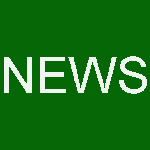 By Pepper Parr By Pepper Parr
BURLINGTON, ON November 14, 2012 Mayor Rick Goldring got the surprise of his life, when he learned that the province expected him to come up with $60 million to pay for a portion of the re-build of the Joseph Brant Memorial Hospital. In the old days, when Goldring was getting his tonsils taken out at JBMH, health care was a provincial matter.
 Paid for by 2018 – they promise you that. But that doesn’t mean they aren’t going to end the hospital levy in 2018. Taxpayers are going to be the gift that keeps on giving. Times do change. The city sucked it up and looked at its taxpayers and said: we have to hit you for $60 million, but we are going to have a great hospital, when this is all said and done. The fact that the new Family Medical centre and the parking garage are being built on a flood plain, doesn’t seem to factor into how “great” that hospital is going to be.
 Those numbers above are your dollars. It represents the amount the city gives to the hospital to pay for building the additions. While the city is collecting a special hospital levy from you now – they tuck that into a bank account and earn interest. At some point the city has to borrow money to make the payments. No matter – the good people of Burlington sucked it up and told every polling organization that chose to ask them that the hospital was THE top priority. That the JBMH Foundation also had to come up with their $60 million seemed to make it all a little easier to bear.
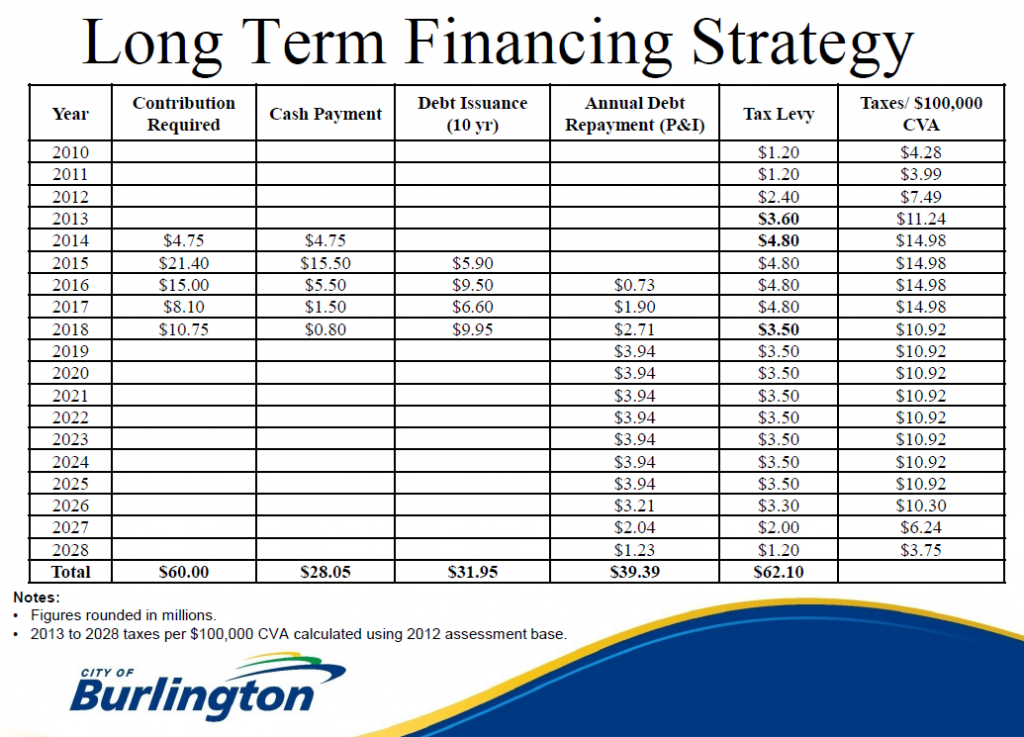 Here is what this means – the number that matters is on the far right. For every $100,000 of assessment value on your home you will pay an amount ranging from $4.28 to as high as $14.98. That’s just what it is going to cost to re-build the hospital that everyone says they want. Continuing to take what started out as hospital levy money after the hospital is built and paid for is what might seem unfair or misleading to taxpayers. The tax levy column, second from the right, isn’t as clear as it might have been. It should read – Tax levy in millions. Learning too that the cost came down to a paltry $3.99 for every $100,000 of assessment on your house made it sound like easy credit. That $3.99 does balloon to $7.49 then to $11.24 and up as high as $14.98 – but those are just details. By the year 2028, when we are assured the Pier will be finished, the hospital will be paid for and we can all visit our family members who are being cared for in a state of the art medical facility.
Not so fast, my Mother used to say as I was scooting out the door to find some mischief.
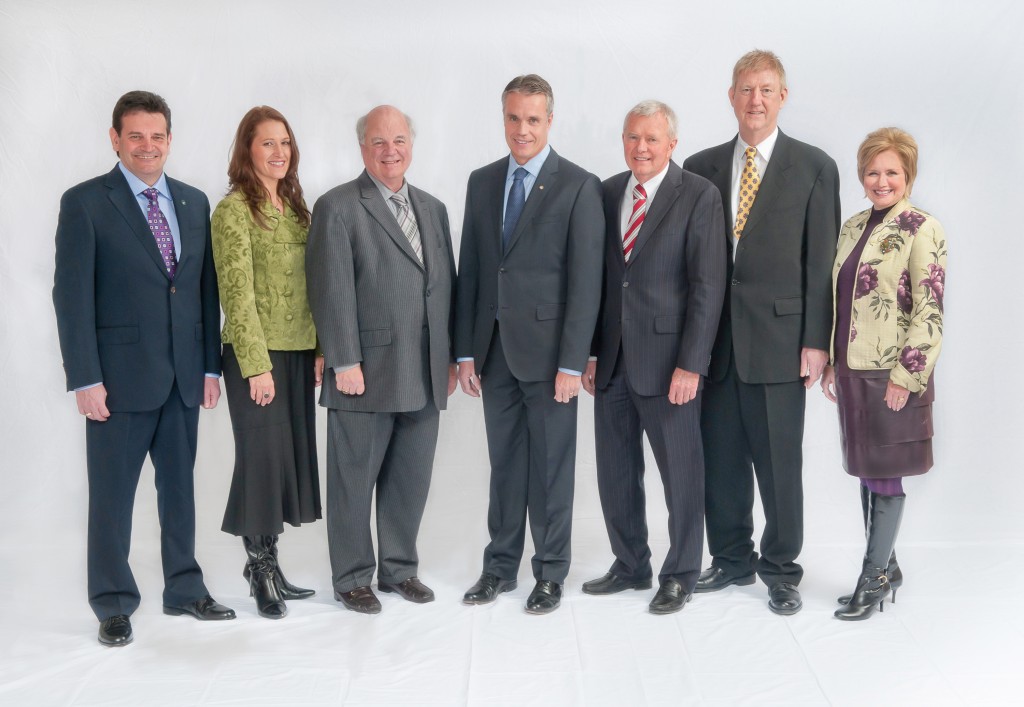 Do you know why they’re smiling? It isn’t because Santa Claus is coming soon. They figured out a way to continue taking the special hospital construction levy out of your pockets. If you managed to pull off a stunt like that you too would be smiling. Turns out that the Significant Seven that serve as your Council are not going to lift that hospital levy come 2028. It will just get rolled over and become part of what you pay in taxes every year.
Call it a sneaky tax grab if you want. Call it misleading the taxpayers, which is what at least one Council member thought of the plan. Councillor Sharman, who positions himself as one of the better financial minds on Council did say that “rather than give it back (the hospital levy) we are going to re-assign it.
Say what you wish. By the time 2028 rolls around none of the rascals who put their hands even deeper into your pockets will be on this earth and with one exception, probably not even on Council. They expect to be able to get away with it.
Is it fair? No – they should be telling you or even better they should be asking you if this is the way you want to be taxed. They won’t ask you directly but, come the next election – you might want to ask a question or two as to how they think they can pull this one off.

 By Pepper Parr By Pepper Parr
HAMILTON, ON November 11, 2012 For Len Lifchus, this time of year tends to be all about the numbers – are the giving’s where we need them to be? Are the various teams on top of their targets? Are we going to be able to raise what we need?
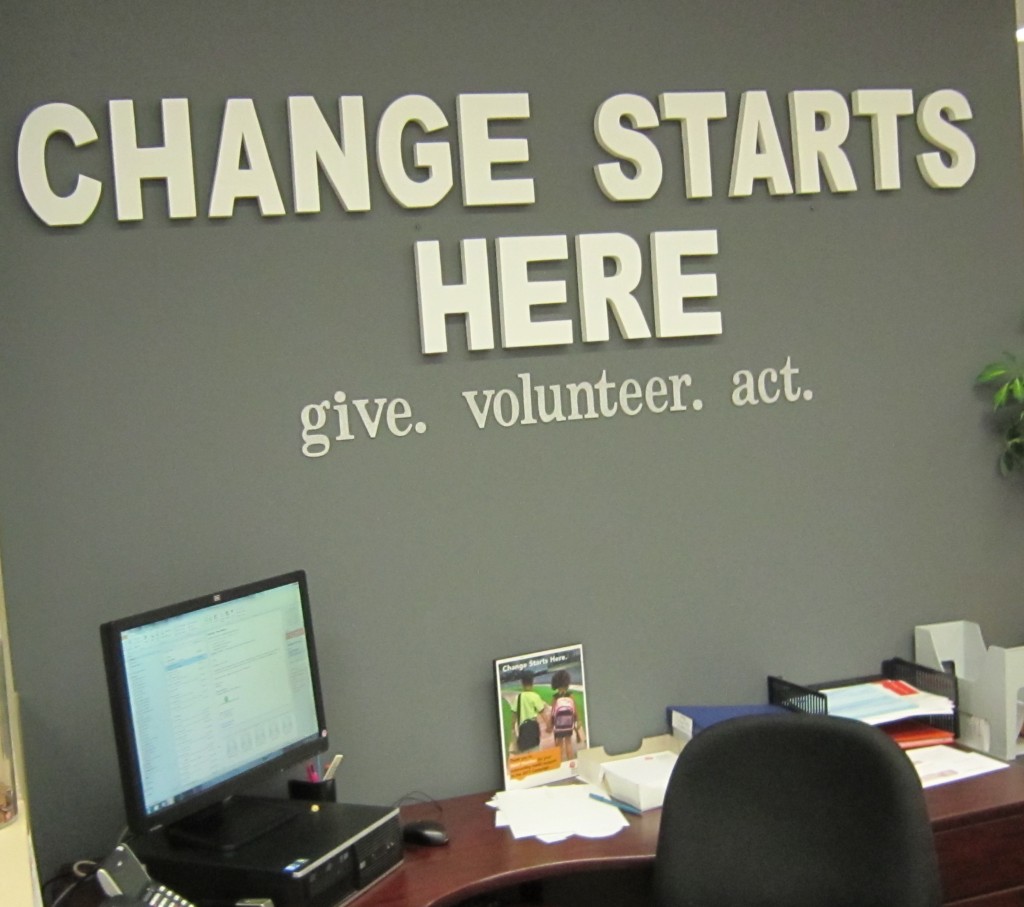 Len Lifchus would like to be in the business of giving people fishing rods and teaching them how to fish and feed themselves but as often as not he is giving them fish because they cannot feed themselves. Len Lifchus would like to be in the business of giving people fishing rods and teaching them how to fish and feed themselves but as often as not he is giving them fish because they cannot feed themselves.
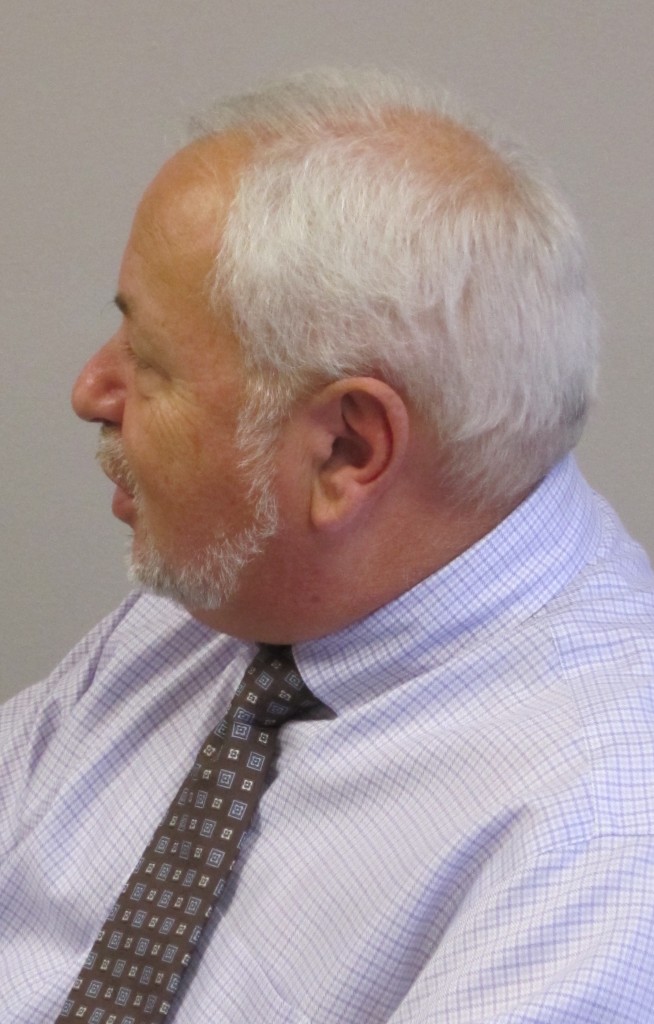 With more than 35 years in the volunteer sector, Len Lifchus guides the Burlington/Greater Hamilton United Way towards raising the $7 million + needed to fund the agencies that provide services needed in the community. For the Burlington/Greater Hamilton United Way, 44% of the 2012 target has been reached. Burlington is a little behind its target. The community has raised $746,834 of the $2.1 million it needs.
Combined Hamilton and Burlington have reached the 44% level but Burlington is lagging and in our part of that pumpkin patch we are at 36% – got more work to do – so if you’ve gotten this far and have not made a pledge – think about what you can give and make the pledge – we will be here when you get back.
Burlington is a very affluent community but there are significant pockets of poverty and Burlington is a more expensive place to live in. Lifchus, who recently moved to Burlington, will tell you “gasoline is more expensive, LINK laundry is more expensive, food costs more”.
Immigrants need help getting settled; there are no major industries in Burlington that need workers. Nutrition is an ongoing problem that comes back to plaque is later when poor health issues become the problem.
The face of poverty isn’t as visible in Burlington; you don’t see it between all the cars parked at the malls. “The faith community is very strong in Burlington” explains Lifchus, but there is only so much they can do. Our food banks are not a fact of life – they were put in place to meet a crisis and the crisis stayed and became a part of life for the poor and now the working poor.
Len Lifchus has been employed by the voluntary sector for over 35 years – more than 16 years with the Canadian Red Cross Society Blood Program and the last 18 years with the United Way.
Born and raised in Vancouver, B.C. and a graduate in political science from the University of British Columbia, Len has spent his adult life on a career path of serving others.
Len joined the United Way in 1995 as the Executive Director of the United Way of the Central & South Okanagan Similkameen and moved to Peterborough, Ontario in 1999 to become the CEO of the United Way of Peterborough & District. After a 10 ½ year career in Peterborough he moved on to become the CEO of the United Way of Burlington & Greater Hamilton – Canada’s 12th largest United Way.
He has watched changes take place in the way we care of those who are not able to take care of themselves. “Food banks were a stop gap measure during a difficult economic phase – now they are full time operations” says Lifchus. “We aren’t geared to run this type of operation the way we have to but without food banks we would have very serious social problems to deal with.
One of the agencies the United Way funds is a program that makes food available to students who are not getting the nutrition they need at home.
The United Way doesn’t run programs; it funds agencies that run programs and each year at the end of the fund raising driver the really hard work of deciding who is going to be funded and who isn’t going to be funded begin.
 Part of the Burlington campaign cabinet – a group that meets under the direction of the Paddy Torsney, the Burlington campaign chair who co-ordinates with Len Lifchus on a weekly basis. The Burlington/Greater Hamilton United Way funds 133 programs and Lifchus is the first to tell you that the issue of poverty is not going away. He will also tell you that people are giving differently. There is much more one-on-one donor solicitation; that is organizations approaching a donour and soliciting funds. When those individual appeals succeed there is less money available to organizations like the United Way that are not tightly focused.
Also, there are more Family Trusts, financial structures that wealthy people use to channel their funds to specific targets – again lessening the funds available to un-targeted organizations like the United Way.
What the United Way does, and can do because it is much closer to the daily grind that is poverty, is recognize evolving needs and fund agencies that are focused on those new needs.
Teen suicide is a growing concern; one that is growing far too fast and no one is quite sure how to address the problem. Community groups, often started by families that have lost a family member to suicide get formed and as they grow the find they need more in the way of support – the United Way is there to help them create the infrastructure they need to effectively develop these agencies.
Managing the fund raising and then managing the disbursement of the funds raised is the day to day part of what Len Lifchus does. He also teaches in the evenings and sits on more boards than there are on a Monopoly game.
Everyone looks for distractions from the daily grind and for Lifchus it is musicals. He can recite lines from some of his favourites. Les Cages aux Folles is at the top of his list along with Hair and Les Miz – and don’t forget Ragtime, all amongst his favourites.
He has been following the selection of “Dorothy” for the next production of The Wizard of Oz– “of course” declares Lifchus, “there is never going to be another Judy Garland”. Lifchus actually gets a little misty eyed when he talks about the musical productions.
Fun and relaxation only take him so far. The Halton Regional Poverty Roundtable is an think group that the United Way is both funding to some degree and providing some of the administrative support. Lifchus fully understands the need to think about the problem of poverty and take a long, deep hard look at the root causes and begin the search for better solutions. “Change” Lifchus will tell you, “starts here.”

 By Staff By Staff
BURLINGTON, ON November 2, 2012 It’s one of those things you know you should do – some of us used to do it New Year’s Day – but there were first day’s of the year when the idea of climbing up on a ladder was not such a good idea.
Then a fire chief somewhere came up with a really neat idea – he said “why not remember to change the batteries in your smoke alarms on the Sunday that the clocks go forward or backward?
That was a really good idea and it seems to have become the practice at least in Canada.
 They work – but only if they have fresh batteries. Every year, we read stories of apartments or houses that catch fire and often, all too often there is some loss of life and we hear a despondent fire chief explaining to a television camera that the smoke alarms did not work because the batteries were dead.
There may be some juice in the batteries you have in that smoke alarm now – but why take the chance. Figure out what size of battery you need and climb up on that ladder and make the change.
This is fall so the clocks go back an hour Saturday night and you get an extra hour of sleep
“Smoke alarms can only do what they are designed to do if they are working,” explained Public Education Officer Lisa Cockerill. “At least once a year, replace the batteries in your smoke alarm with new batteries and test all smoke alarms once a month.”
Push the test button for 10 seconds. If you hear the alarm it means its working. No alarm? It’s time to replace the battery or the unit. Smoke alarms should be replaced after 10 years.
It’s the law to have working smoke alarms on every storey of the home and outside all sleeping areas. For added protection, it is recommended to also install smoke alarms inside all bedrooms. In order to survive a fire, you need to be provided with an early warning and know what to do when the smoke alarms sound. Have a fire escape plan with a meeting place that everyone in your family knows.
Assistance is available for seniors and persons with disabilities in the community who are unable to replace batteries or test their smoke alarms on their own. For more information or request assistance with your smoke alarm or for fire safety information please call 905 333-0772, ext. 6333.
Tampering with, or removing the batteries from your smoke alarm is against the law. Failure to comply with the Fire Code smoke alarm requirements can result in a ticket for $235 or a fine of up to $50,000. For further information visit www.burlington.ca/fire.

 By Pepper Parr By Pepper Parr
BURLINGTON, ON October 30th, 2012 Last week was a great week for the United Way in Burlington, announcing that they had reached the 25% level of the $2.1 million they need to raise – and we are not about to stop at that level are we? One of the United Way agencies put on an event in the parking lot of the United Way offices on Harvester Road that had three Food Trucks on the property selling lunches.
Cup Cake Diner had to pull out at the 25 minute mark – they were sold out. Gorilla Cheese and HankDaddy BBQ each had line ups of more than 50 people in front of their trucks. That is called a SELL OUT!
Then on Sunday there was a Fashion Shoe at the Rude Native on Brant. $25 got you a light lunch and a look at some new fashion pieces.
 C C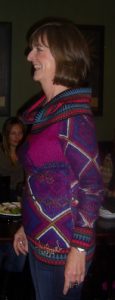 heck out the apparel that was on display. Burlington United Way Chair Paddy Torsney and one of her side kicks Kendra Mullen took to the runway – sorry, we don’t have the names of the other models. heck out the apparel that was on display. Burlington United Way Chair Paddy Torsney and one of her side kicks Kendra Mullen took to the runway – sorry, we don’t have the names of the other models.
Our reports are that it was a fun event that everyone enjoyed.
The city of Burlington held their annual truck pulling event outside city hall which was a successful event. Kim Phillips, one of the city’s two General Managers is working on the rest of the public sector to increase the giving at that level – that being the federal and provincial governments and agencies.
What really works for the United Way – and for you the citizen, is the payroll deduction plan. It can be as little as a dollar a paycheque – choose the number that reflects what you can manage. And if you need to bow out for a period of time – all that takes is a phone call.
Here’s what happens when you go the payroll deduction route. You see the gross payroll figure and then you see the CPP deductions (you will retire at some point) and then you see the EI deduction and hope you never have to make a claim. Then you see the United Way deduction and you can pause for a second, smile and know that you’re helping. It may not be much but when Len Loftus, chief cheese of the United Way operation for Burlington and Hamilton sees those combined numbers he is one happy camper – because he is the guy that has to figure out how much he can make available to the Food for Thought people – they are the ones who make meals available to kids who leave the house in the morning without a breakfast in their tummies. Or how much he is going to send to the Nelson Youth Centre that provides group based treatment intervention which supports and strengthens the ability of children and youth to develop more effective social and emotional skills. This program includes a mandatory parental program.
 Why do people line up like this to buy lunch? Because they know a portion of the proceeds are going to the United Way. The Food Truck program was such as success that plans are already being made for a repeat performance next year. The agencies that get the funds the United Way collects came up with the idea for the Food Truck event. It went so well that Gayle Cruikshank said the agencies want to make this a yearly event with proceeds going to the UW.
They all matter, they all need help and there is never enough to cover all the bases. Loftus has to wiggle and jiggle his numbers and hope that there is at least enough to cover those bases.
When you sign that payroll deduction card you are doing two things – helping in a real, measurable way and cutting down on the amount of wiggling and jiggling that Len Loftus has to do each year.
The theme for the United Way this year is Change starts here – it really starts at your pay cheque and being prepared to give some of it to those who need help.

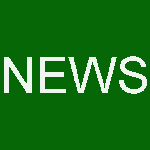 By Staff By Staff
BURLINGTON, ON October 10, 2012 – In what they are describing as a program to bring expanded healthcare services closer to home the provincial government has announced a new program that allows the delivery of some services from pharmacists including the publicly funded flu shot and getting their prescriptions renewed.
In addition to giving the flu shot, pharmacists can now also:
Renew or adapt existing prescriptions
Prescribe medication to help people quit smoking
Demonstrate how to use an asthma inhaler or inject insulin
Support patients who have a chronic disease, such as diabetes, monitor their condition
 There are some people who never get used to a flu shot. These can now be given at a pharmacy – don’t need to go to the doctors office Expanding the role of highly trained pharmacists is part of the McGuinty government’s Action Plan for Health Care. The plan gives Ontarians better access to family doctors, nurse practitioners and other health care providers, to ensure that health care dollars are spent most efficiently.
This will be the 13th year the flu shot has been offered in Ontario.
People (over the age of five) can visit participating local pharmacies starting Oct. 22 where specially trained pharmacists will give them the flu shot as part of Ontario’s Universal Influenza Immunization Program.
Hopefully the line up at the drug store will be less than the waiting time in a doctors office.

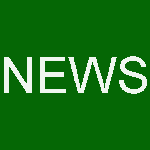 By Pepper Parr By Pepper Parr
BURLINGTON, ON October 5, 2012 He may be a former Mayor and a former MPP – but he is still very much a citizen of Burlington and when the call comes Cam Jackson is there to do his bit.
Food banks are where Jackson likes to be – he sees the need and he just plain likes being around people. He is Chair of the Burlington Food Share that benefits the Salvation Army and others through their seasonal food drives.
Jackson has been part of this program for a number of years.
 You should have gotten one of these bags in your mail box. Fill it up and drop it off – there are people who aren’t able to shop for food this weekend. Earlier this week most households in the city had a brown paper shopping bag with the Burlington Food Share logo on the front listing all the places we could drop off the bag once we had filled it with groceries. It’s an impressive list – and hopefully all that donated food will meet the need this Thanksgiving weekend.
What many may not have seen was the line at the very bottom of the bag – Thanks for Sharing,Cam Jackson, Chair, Burlington Food Share.
The Burlington Community Foundation Vital Signs report released earlier this week said that 63% of the people who used a food bank this year have used food banks for more than three years. That is not an impressive number. It’s people like Jackson who keep Food Share going.
You may not have voted for Jackson – but let him know that he did have an impact and that we appreciate what he does for the community he represented and led.

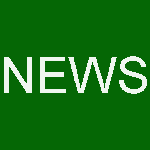 By Pepper Parr By Pepper Parr
BURLINGTON, ON October 3, 2012 Well we now know what the Joseph Brant Memorial Hospital campus is going to look like and Councillor John Taylor knows what the parking garage he didn’t want to pay for looks like as well. It’s all pretty nice actually and it is certainly going to change the Lakeshore Road that we have today into something very, very different.
The unfortunate part of this story is that the news was delivered to about 25 people from Ward 1 who happened to hear of the meeting.
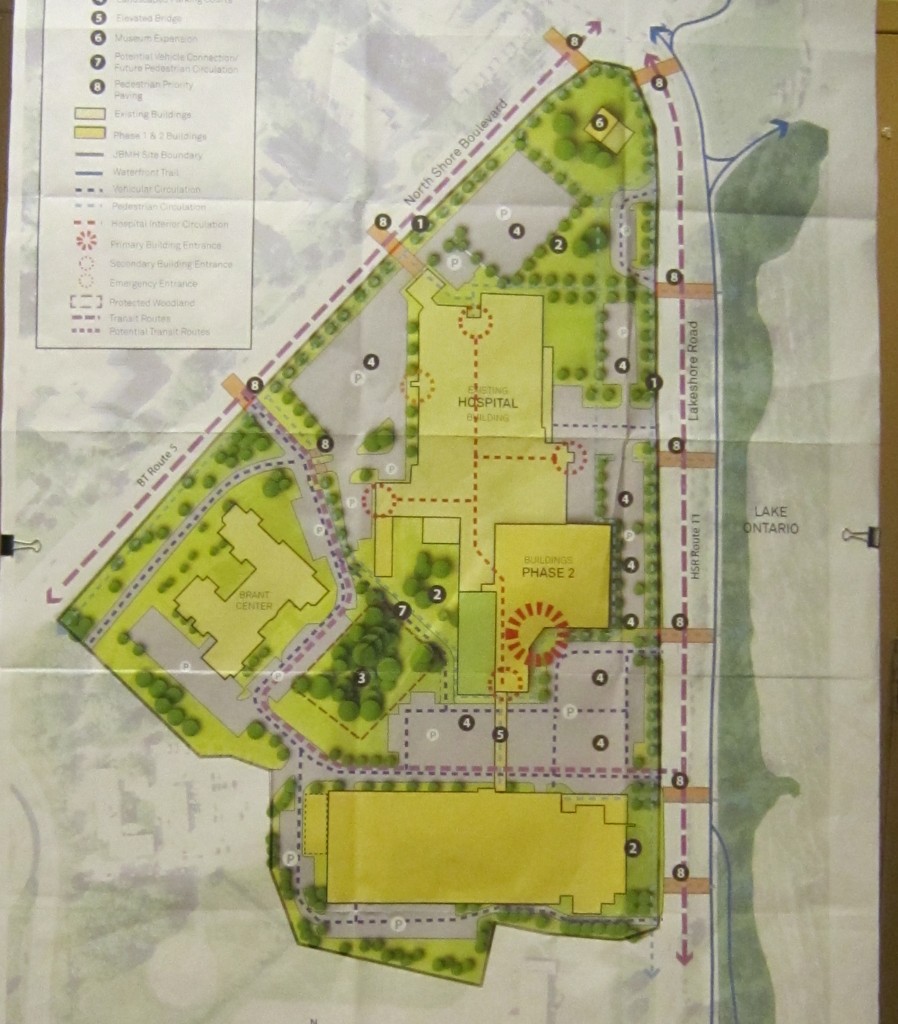 This is what the Joseph Brant Memorial Hospital “campus” is going to look like when all the construction is completed in 2017-18 The front entrance will be oriented to the lake. That red circle on the lower right, near the number 4 will become the new entrance. There will be several entrances to the hospital. The emergency entrance will remain where it is. The Family Medicine clinic and the parking garage are at the bottom # 2 There will be a roadway through the “campus” – that’s where the number 8’s are. The hospital is far too important an institution for this news to be delivered to such a small crowd. Councillor Craven sold the city short when he limited the distribution of this news. This event should have taken place in the Family room of the Performing Arts Centre or in one of the rooms at the Art Centre.
The story is here for your viewing pleasure.
The garage is going to be four stories with a structure that will take an additional three stories if needed in the future.
The garage is at the western end of what the hospital is now calling a “campus” – which is a nice name for the place. At the front of the garage, facing Lakeshore Road, the new Halton McMaster Family Clinic will be placed. There will be an elevated, climate controlled walkway from the parking garage directly into the new addition to the hospital that will be built once the garage/Family Clinic is completed.
 This structure, a combination of a Family Clinic at the front – on the left – and a four level garage, with the capacity to be grown to seven levels, is Phase 1 of the JBMH renovation. The walkway, shown on the right, will allow people to walk through a climate controlled passageway right into the new addition to the hospital when it is completed in 2017-8 The building of this structure is Phase 1 of the renovation of a hospital that was built in 1961 and has had few fixes to the structure since then. The upgrade, which is going to cost something in the order of $300 million, will be complete sometime in either 2017 or the year after.
Taxpayers are contributing $60 million, the Hospital Foundation is contributing an additional $60 million with the balance of the money coming from the province.
What are we getting for our money? A very different community medical service.
 Site Planning co-coordinator Jamie Tellier explains what is going to be built where on the JBMH campus. The Family Clinic, which will be a teaching hospital, will have six family physicians and ten residents. All the family practitioners will have privileges at JBMH and those doctors who have privileges at the current JBMH will be able to apply for privileges at the new Halton McMaster Family Health Centre.
Eric Vandewall added a very positive note when he explained that doctors who train at a hospital often stay in the community once they have completed their training – a nice way of saying that we are going to have new doctors. The plan is to have them in place by the end of 2014.
Henry Decker, the hospital official who is overseeing the building of Phase 1 explained at the meeting that he expects to have a building permit in hand by the end of the year and shovels in the ground very early in January, which was a concern to people who live at the Maple-Lakeshore Road intersection where there will be some construction traffic for a number of years. Councillor Craven who hosted the event assured residents that his office would do everything it could to “mitigate” the traffic problems.
There is much more to tell you about what is being built but we want to get these pictures posted – we will come back with more detail.

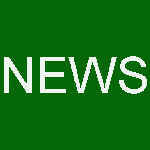 By Pepper Parr By Pepper Parr
BURLINGTON, ON October 3, 2012 A robust crowd gathered early in the morning at the First Credit Union branch to be taken through some “vital signs” about our city – it was not a pretty picture.
The research report, launched by the Burlington Community Foundation, measures the city across ten areas of focus, including health and wellness, environment, youth, and newcomers.
 Burlington Community Foundation Tim Dobbie confers with Executive Director Colleen Mulholland about the research report with some stunning data that was made public on Tuesday. “As a public foundation created by and for the people of Burlington, we help people, corporations and agencies accomplish their charitable goals and address our city’s most pressing needs,” said Colleen Mulholland, Executive Director of Burlington Community Foundation. “To accomplish our mission, we first need to deeply understand the community: our strengths as well as areas of need. This is why we have created our first-ever Vital Signs report, a community check-up that evaluates Burlington as a place to live, work, learn and grow by identifying trends that are critical to our quality of life.”
Burlington is a prosperous and affluent community where its individual, household and family median income is 20% higher than Ontario as a whole. This means it is sometimes harder to see the gaps that exist between rich and poor and the rise in mental health issues among youth. .
We are growing, but not at the rate we have grown in the past and in a direction that brings a lot of problems with it. More than 80,000 of the 174,000 people in Burlington are over 45 years of age and 1 in 5 of us come from some other country.
 To fully appreciate just how wealthy we are as a city – look at that field in the middle of the stadium. Burlington’s parks equal 3,303 of those football fields. Burlington has 1463 hectares of parkland – which is the equivalent of 3,303 football fields. That is a lot of parkland.
In a telephone survey to 300 people done by an outside research firm, more than 91% of the people called in Burlington said they donate money to others who are less fortunate.
More than 33% of the people in Burlington volunteer some of their time to helping others make the city a better, nicer place to live.
That’s the plus side – we are, on paper at least, a caring, giving community.
More than 42% of the people in Burlington earn more than $100,000 a year.
The value of the average home in Burlington is $466,000.
We are a rich community as well but we aren’t all rich.
The bad news is very painful. The vacancy rate for apartments is 1.3% which means the market is very tight and that drives up prices. Nice for the landlords but very, very hard for those living below the poverty line – and Burlington has a lot of people living below that poverty line.
The researchers tell us that within a decade we will see 24% of the population living below the poverty line.
Day care in Burlington costs $60 a day. It isn’t possible for low income people to afford day care at that price,which means they don’t work and require social assistance.
 We know who does the bullying and we know for the most part where it is being done. Why aren’t we able to bring an almost immediate halt to this kind of behavior. Is the problem with the children who do the bullying or with the parents of those children. That wasn’t a polite question. 31% of newcomers live in poverty – given that 1 in 5 of us were not born here – that is not a nice number.
24% of the minorities live in poverty.
24% of those who are unattached – a polite word for single mothers, live in poverty. That poverty just grinds these women down and their children suffer.
63% of the people using food banks have been doing so for more than three years. Many thought food banks were a top gap measure. For far too many their trip to the food bank is your trip to the supermarket.
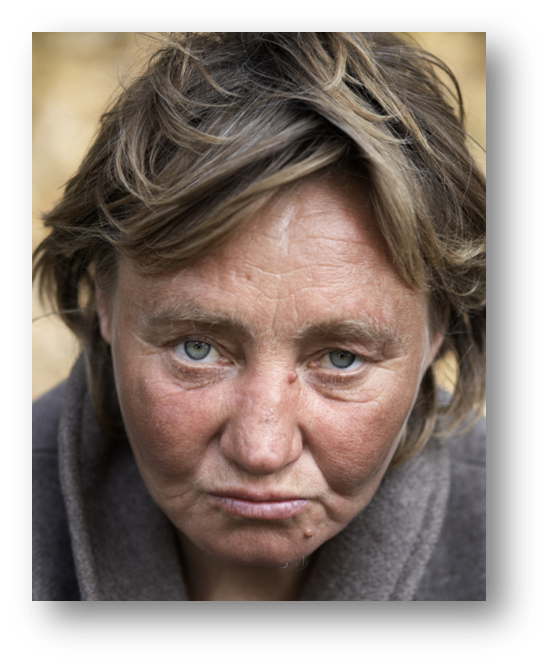 This is what poverty looks like – bleak, cold, few prospects and little hope. What does poverty look like? Living on $20,778 a year with one in three living in extreme poverty – getting buy on less than $10,389 a year.
In her remarks Colleen Mulholland told of a woman who said she has to steal to care for her family. Why is this happening?
31% of newcomers in Burlington live under the poverty line and tend to earn 50 cents for every dollar other people earn.
Our social problems are not limited to the newcomers. Our youth are suffering from problems they see as staggering. Four out of every 12 young people between the ages of 12 and 15 experience bullying. We know who is doing the bullying – why have we not managed to have it stopped?
Between 10% and 15% of the teenagers have thought of harming themselves.
Between 19% and 27% of teenagers feel they have too many problems.
Between 6% and 11% of teens have thought of committing suicide.
This is a part of the rosy picture we paint of the city we call the nicest place to live in Canada.
When the data was delivered to a room of more than 60 people, BCF chair Tim Dobbie, with a dazed look on his face said “Wow”! It was not a happy wow. He followed that up with a “so what do we do now?”
And indeed that is the question – what do we do now?
Why do we have these problems? Is it all the result in an unequal distribution of the wealth we have? Is it because parents are too busy to do their job of raising their children? Are the schools failing us? Is this happening because we are no longer much of a faith based society?
 Len Lifchus, CEO of the Burlington/Hamilton United Way, the organization that raises funds which are delivered to agencies that deliver support services, listens to data he is all too familiar with. These aren’t polite questions – but when a parent is called to the hospital to talk to the emergency staff about their child having harmed themselves or worse, and this is happening now; when the police knock at your door to tell you that your child has committed suicide, being polite just doesn’t matter anymore.
This report comes out as we get into the 2012 United Way campaign where we need to raise $2.1 million to take care of those who live under that $20,778 poverty line and especially for those that have to try and get by on $10,389.
Do we see the link between the drug use and the social problems? Our Burlington covers the police stories and note that the police are kept very busy tracking down the drug dealers. Having been offered a “joint” as I was coming out of the library a number of months ago I can attest to the size of the problem – the kid was less than 20, taking a break and inhaling that funny smelling cigarette. We all recognize the smell – do we recognize the problem?
It was a tough report that we had to hear and the BCF people deserve full credit for seeing the need and the courage to put the facts before us. Hopefully we will have the courage and the concern to do something about those facts.
Vital Signs is a community check-up conducted by community foundations across Canada that measures the vitality of our communities and identifies significant trends in a range of areas critical to quality of life. The check up is coordinated nationally by Community Foundations of Canada.
The Burlington Community Foundation was established in 1999 by a passionate group of local volunteers and philanthropists to improve the quality of life in Burlington. Several of the city’s former Mayors were instrumental in getting the organization off the ground.
The initial funding came from a Mayor’s Gala sponsored by Rob MacIsaac; the first meeting of the Foundation was chaired by former Mayor Walter Mulkewich.
The Foundation helps people create funds and support meaningful local causes. The Foundation’s experts understand the community and help donors respond to vital needs by providing grants to charities.
The Masquerade Ball, the Foundation’s annual fund raising event tries to sell 600 tickets to the event. They have a lot of fun and the expensive tickets raise the money for the Foundation to operate.

 By Pepper Parr By Pepper Parr
The people numbers were up – the money numbers were down, but the Terry Fox run was a major success nevertheless.
It was the 31st time the event took place in Burlington. To date the community has raised $1,470,000 and countless numbers of Burlingtonians have run for Terry Fox and for those who found themselves facing cancer.
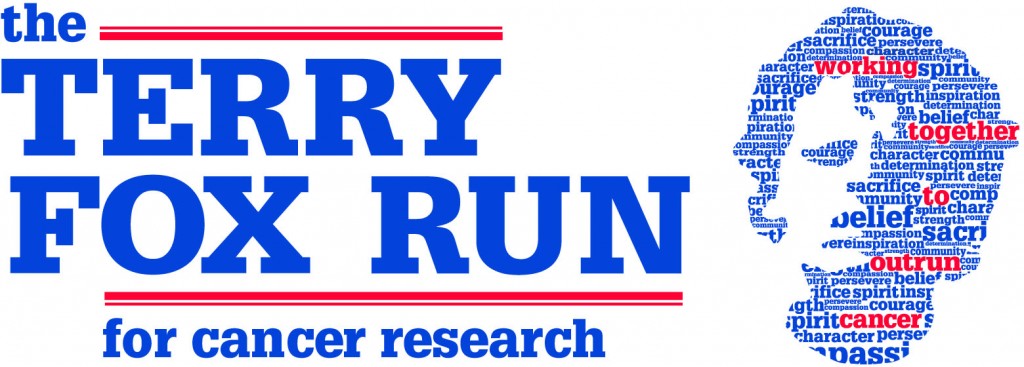 Don Carmichael, chair of the 2012 run, and expected to chair the 2013 run as well, noted that this year “we had a group running with more than 200 members. That was very, very significant and is a large part of what the Burlington Terry Fox run is all about.” Don Carmichael, chair of the 2012 run, and expected to chair the 2013 run as well, noted that this year “we had a group running with more than 200 members. That was very, very significant and is a large part of what the Burlington Terry Fox run is all about.”
More than 1,100 people participated in the run this year. “We printed up 1000 ribbons for people to wear and ran out”, said Carmichael. “It was a very good crowd this year”, he added.
The fund raising didn’t do as well. $84,000 was raised in 2011 while just $70,000 was raised in 2012, bringing the total raised by the Burlington Terry Fox Run since its inception to more than $1,470,000 That is a very significant sum of money.
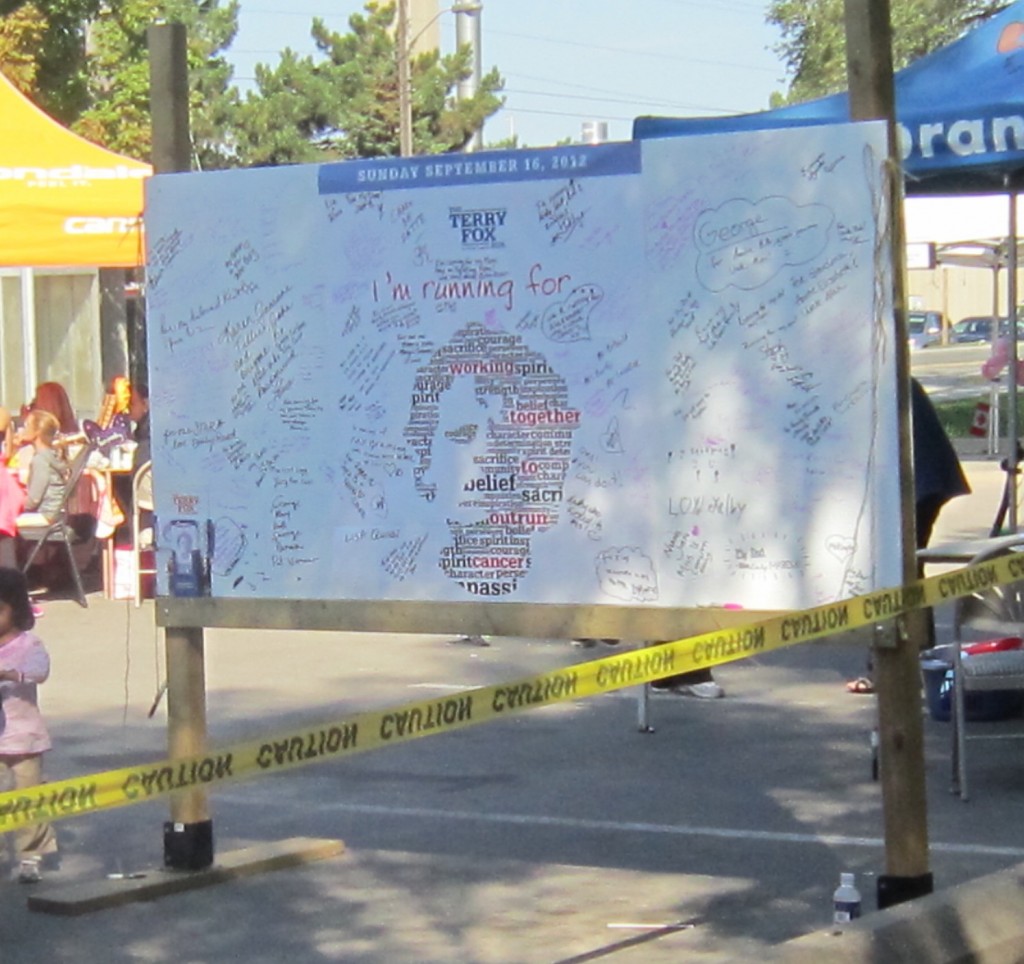 Commemoration boards were set up on the site for people to write a few ords on. What few know is that the organizing committee has kept every board ever set up and written on. They are set up each year in a quiet corner where pople can go and read what they wrote in the past. Every dollar raised in Burlington goes to cancer research and while the run doesn’t have an official sponsor there are organizations in Burlington that come forward to meet the needs that range from water to food. This level of support is hugely appreciated by not only the people who organize the run but by the community at large.
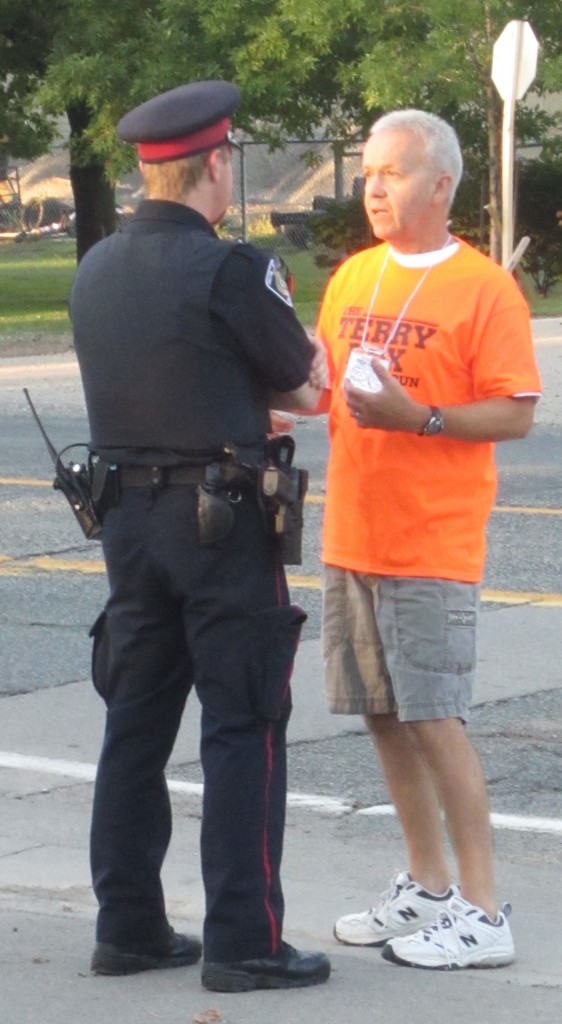 More than 100 volunteers make the Terry Fox Run happen. Carmichael noted that they were seeing more “teams” groups of people running to remember someone or support someone fighting cancer. “In the past” said Carmichael, “we have had smaller groups running – three or four, sometimes a dozen or more. The team running for Casey Cosgrove this year exceeded 200 which is a big change for the run.”
Many people find that the run is a way to commemorate a person and to use the time those who walk the route need to think about, celebrate or miss the person they are “running” for.
 Many people see the Terry Fox run as a unique thing that happened in Canada and was the result of one Canadian’s supreme effort. The Canadian flag just seems to be a part of the event – and there were plenty of them handed out. The event is as much a community event as it is a single person running, with each person having their own personal reasons for being there, but everyone on the site for the same reason – they want to see cancer beaten.
Great strides have been made in research and many forms of cancer are treatable and cured if caught early enough. Carmichael expects to see more groups being formed to take part in the event.

 By Staff By Staff
BURLINGTON, ON October 22, 2012 In the week we are going into more than 4,000 Halton students will spend a part of a day taking part in the seventh annual Halton Children’s Water Festival (HCWF) being held from September 25 to 28, 2012.
Students from grades two to five registered to participate in the festival taking place outdoors at the picturesque Kelso Conservation Area in Milton.
 He really wants you to look at the bullfrog he is holding. Students at the Festival will experience a unique opportunity to learn about water in a fun and interactive way at activity centres which cover Ontario curriculum requirements. New this year, French language activity centres will be piloted with grade five French Immersion students on Thursday, September 27. The HCWF features nearly 60 activity centres that incorporate four main water related themes:
 Kids + water = fun and noise – all part of the Halton Children’s Water Festival. A full day of fun at a cost of $5 per student. “Since the Halton Children’s Water Festival began in 2006, more than 25,000 children have participated which shows the demand and interest for high quality environmental education in our community,” said Conservation Halton Chairman John Vice. ”The Festival’s success is due to the enthusiastic participation by volunteers, teachers and students backed by the commitment of partner organizations as well as tremendous support from individuals and businesses in the community. We thank everyone who has participated and contributed to the Water Festival over the past seven years.”
The Festival is co-hosted by Conservation Halton and Halton Region in partnership with, the Halton District School Board, the Halton Catholic District School Board, the City of Burlington, the Town of Halton Hills, the Town of Milton, and the Town of Oakville. This partnership has created a successful and financially sustainable water festival in Halton. Conservation Halton Chairman John Vice and Halton Regional Chair Gary Carr serve as the Festival’s honorary co-chairs.
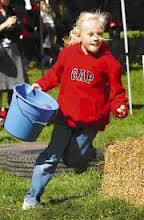 It isn’t all classroom stuff – just look at the way this girl rounds the bale of hay. A winner for sure. The Festival is a community partnership dependent on more than 150 volunteers each day to help with various activities. Halton high school students and community volunteers are once again generously offering their time and gaining experience in community outreach, public speaking, teaching and time management.
The Festival is offered to Halton schools at a cost of just $5 per child, which includes a full day at the Festival as well as transportation to and from the event. Schools seeking Ontario EcoSchools certification can count their attendance at the HCWF as a field trip in the Curriculum category.

 By Pepper Parr By Pepper Parr
BURLINGTON, ON September 21, 2012 It would have been great – as it was it was very good. The rain spoiled the public participation but it didn’t stop two chef’s from Spencer’s on the Waterfront from showing a small crowd that huddled under umbrellas as Chris Hayworth and Andy McLean put together two really fine meals at an outdoor location in what the Farmer’s Market called Street Fight # 1 with Hayworth vs McLeod. The knives were out.
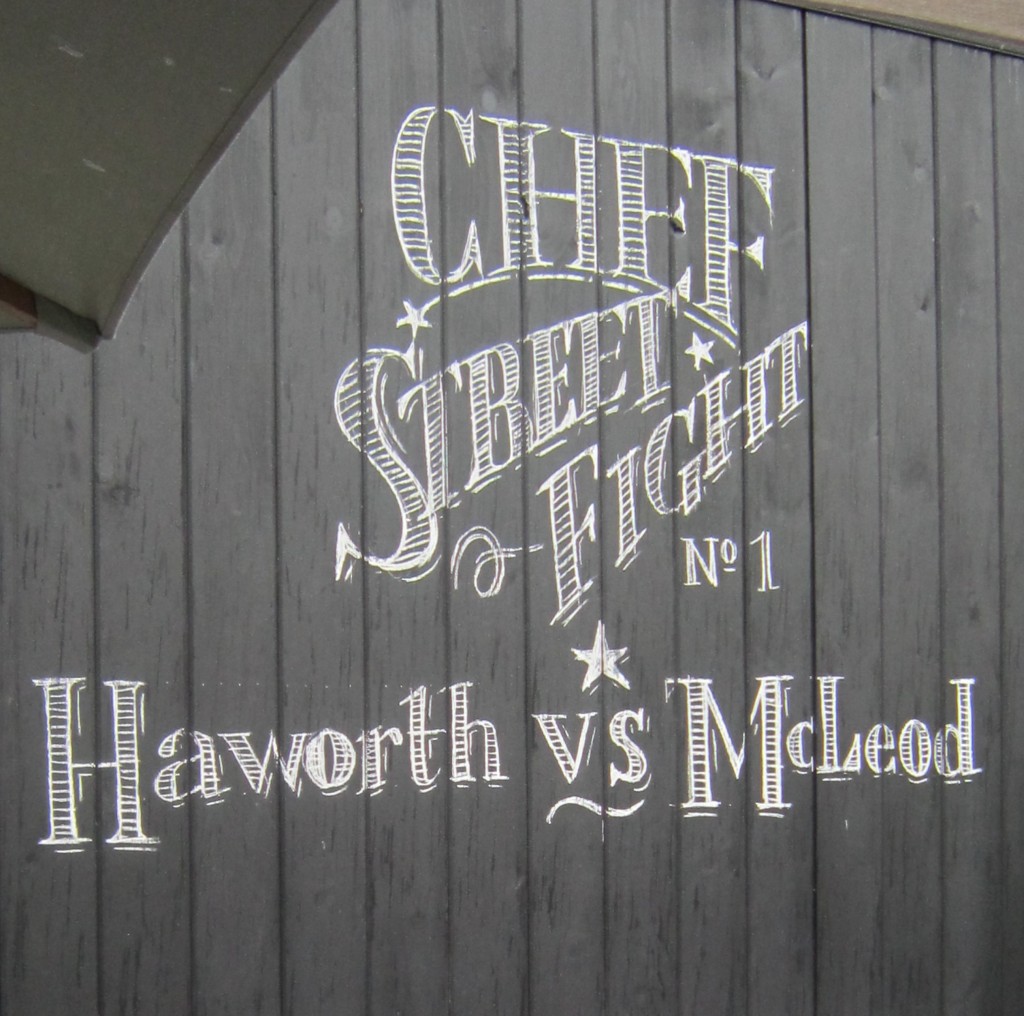 You don’t see hand drawn type like this very often It was promoted as a Street Fight # 1, indicating that this would become an ongoing event. The first pitted two experienced chef’s from one of the better, if not the best, restaurant in the downtown area.
While the rain certainly dampened the public attendance the event was clearly something that could be done fairly frequently next season. If promoted effectively it could become an event to which day tourists travel to Burlington to take in.
The crowd that was on hand last Friday certainly enjoyed themselves even if they had to huddle in the rain under umbrellas tasting the results. Hayworth’s cauliflower soup was especially nice.
While the competition was to have two chef’s competing the event turned out to be a battle with the elements. With just drizzle, one umbrella was enough; but when it turned into real rain – Barry Imber went looking for as many umbrellas as he could find. His finds and what others had on hand kept most of the rain off the audience.
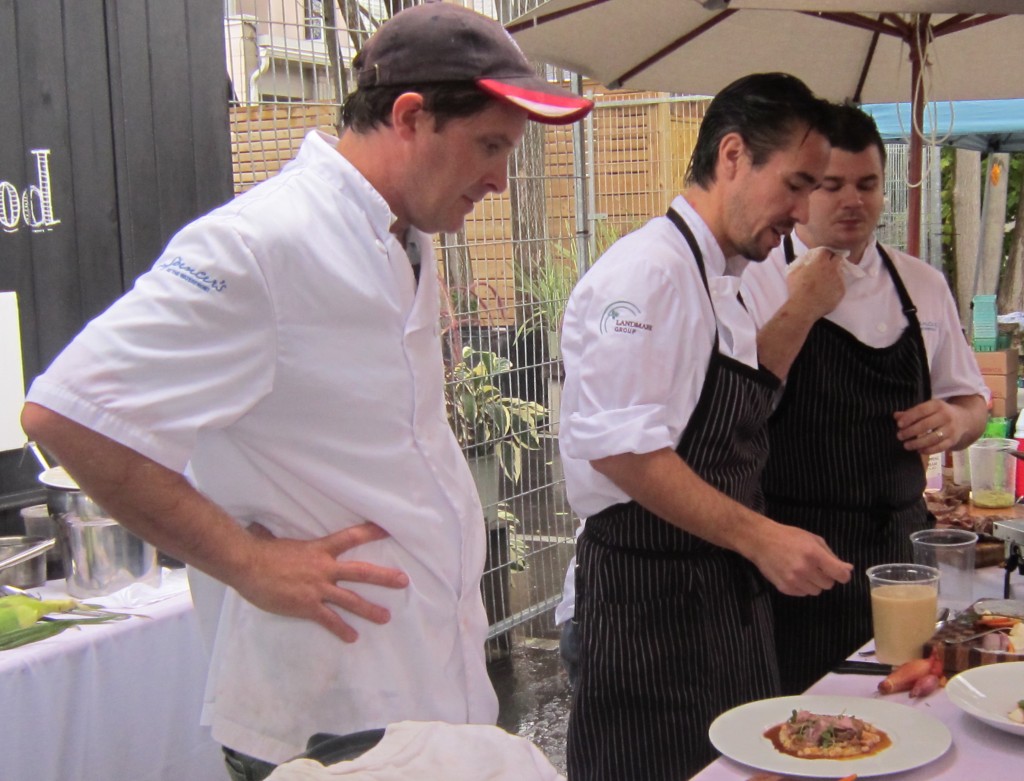 Chef Hayworth on the left and Chef McLean next to him take their recipes through the final stages of preparation before letting the crowd taste the meal – and it most certainly was a meal. 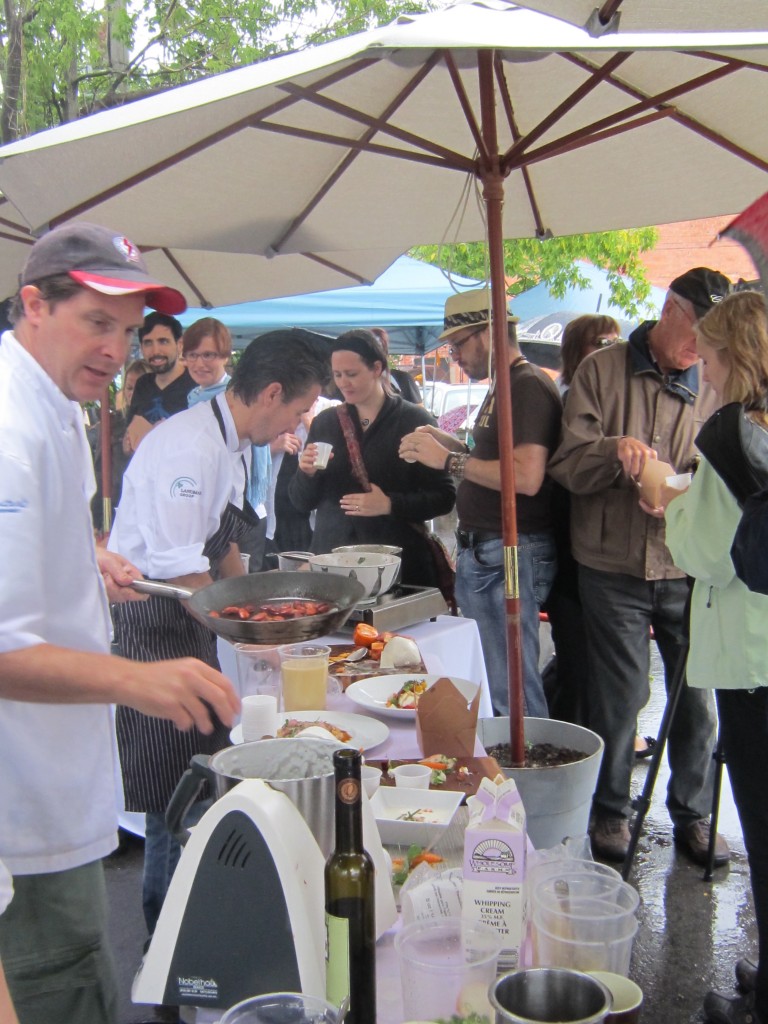 Chef Chris Hayworth on the left with chef Andy McLean to his left prepare food for individual tastings. There wasn’t nearly enough to go around. The original plan was to have people sitting on benches observing; but the rain had people huddling around the cooking tables, while the chefs worked in very cramped quarters constantly hoping the electrical cables wouldn’t short out. The Farmer’s Market will shut down sometime in October and has to be seen as a success – not a raging success but a very positive addition to life in the downtown core.
Our Burlington supported the event from its very beginning and we will be reminding you about its return in the Spring.
Barry Imber is the driving force behind the concept and the guy who did much of the hands on work to make it happen. He was the guy who made the phone calls to get people to take part; he was the guy who chased down umbrellas and put them up as the rain moved from a drizzle to a real rainfall. He was the guy who went looking for additional electrical extension so the chef’s could continue cooking.
 One of the vendors teaches children at the Farmer’s Market some hand clapping dances There were different vendors throughout the year with Featherstone and Plan B on hand consistently. Some vendors were on the site when they had product – Gibson’s Honey who sold out every time he was there.
There were people from the Tourism office watching the event which many thought could be something done several times during the season and promoted as a destination event. There people who would love to make a day trip to Burlington to attend an event likes this, stay for the day and drive up into the Escarpment. As an event – it has potential.
The market is intended for those people who are purely organic. If you want pure food with nothing added, no preservatives or colouring to make the food look nicer.
What many wondered as the two chef’s worked away was – who was doing the cooking at Spencer’s while Hayworth and Mclean were at the market.

 Part 4 of a 4 part Terry Fox Run photo essay. Part 4 of a 4 part Terry Fox Run photo essay.
By Pepper Parr
BURLINGTON, ON September 17, 2012 It was for the COZ – there were close to 200 people wearing the small piece of paper that read Team Casey.
There were T-shirts, several handmade creations that said they were there to support Casey Cosgrove as he battles cancer.
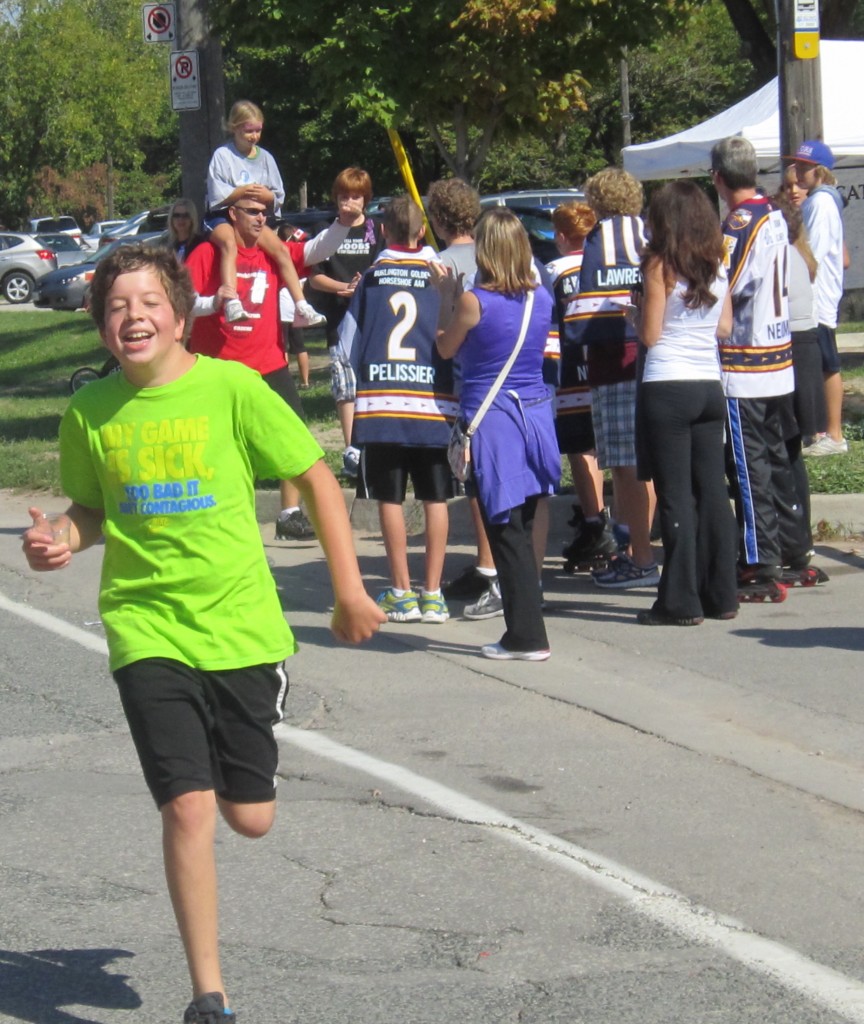 Parts of Team Cosgrove As Deb Tymstra was having the walkers get into the line in front of the starting gate – someone had Team Casey at the other side of the starting gate. There were so many Team Casey people that the walkers couldn’t get started until the Team Casey people were out of the way. So Deb Tymstra put them through a warm up exercise given by the Cedar spring ladies. Eventually, the photo shoot was done and the Team Casey people worked themselves into the walking line and Don Pace did the – Get Ready, Get Set and Go call.
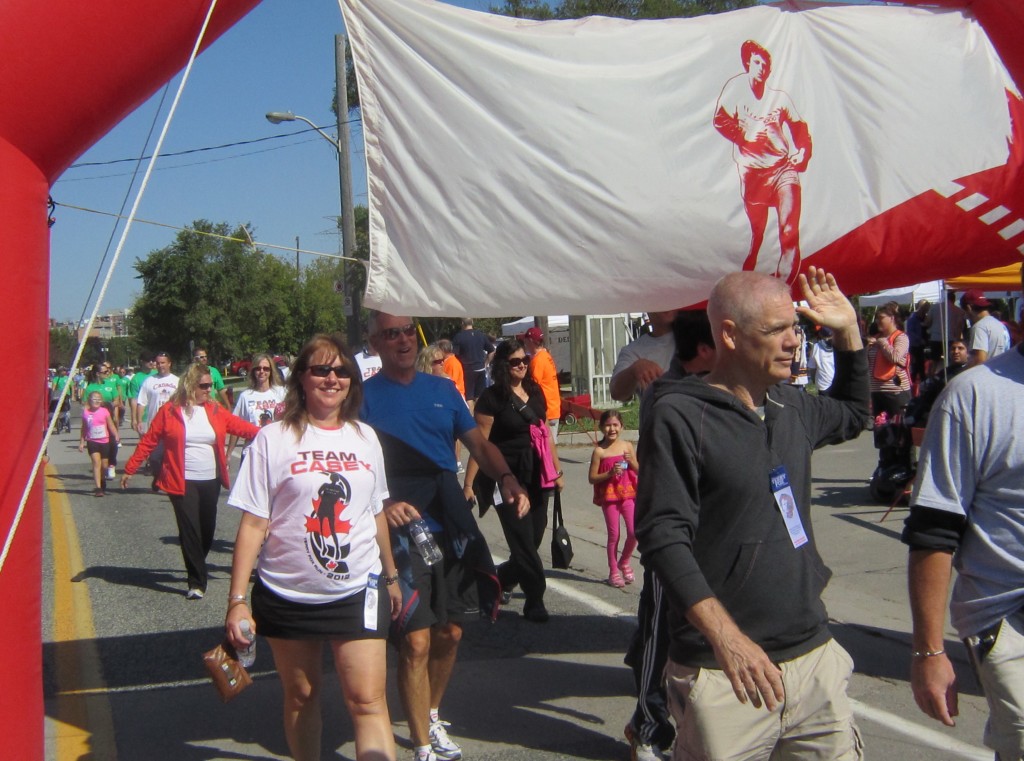 The Team Casey members were easily recognized. Besides being the biggest group they were probably the noisiest as well. There was never any doubt when a team member crossed the finish line. They were walking for Casey Cosgrove and along the way appreciating who he was and what he has done for his community. They thought about the really funny stuff that pops up on his Facebook page and they wondered as well about how much Terry Fox has done for cancer research.
It is cancer research breakthroughs that offer Casey the hope and the opportunity to beat the cancer he battles. Casey is quite open about his struggle. He has good days and bad days – but he has hundreds of friends to support him.
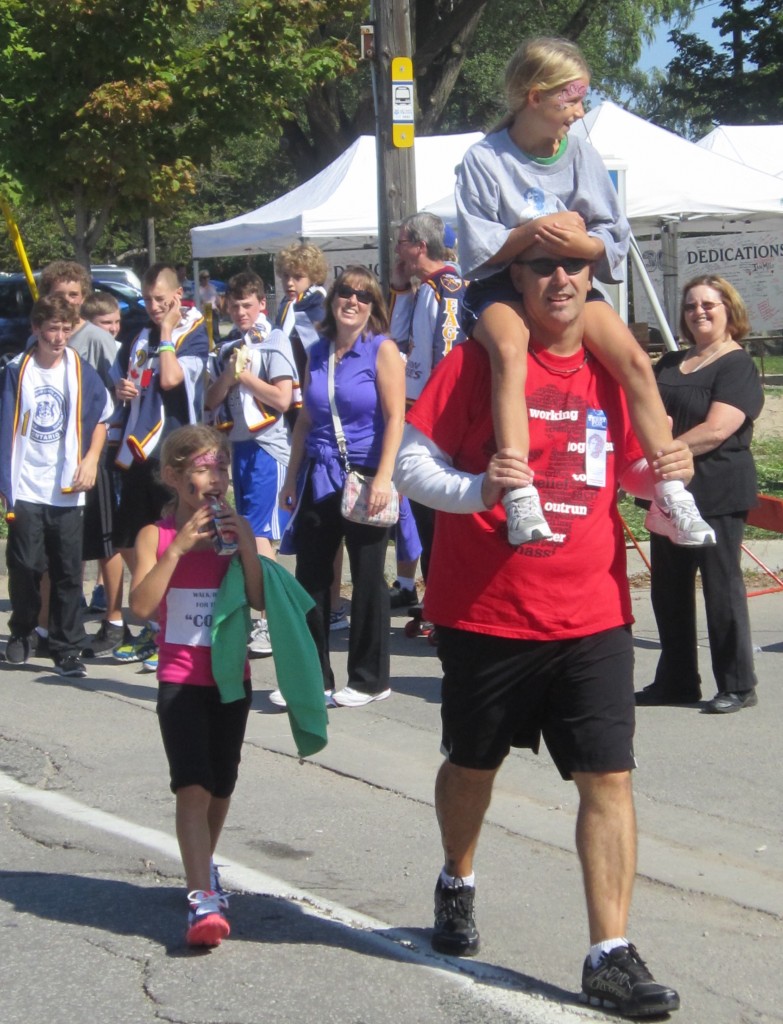 Part of bearing the load. Top two members of Team Cosgrove Terry Fox brought the same robust attitude to his situation: he refused to regard himself as disabled, and would not allow anyone to pity him, telling a Toronto radio station that he found life more “rewarding and challenging” since he had lost his leg. His feat helped redefine Canadian views of disability and the inclusion of the disabled in society. Fox’s actions increased the visibility of people with disabilities, and in addition influenced the attitudes of those with disabilities, by showing them disability portrayed in a positive light. Rick Hansen commented that the run challenged society to focus on ability rather than disability. “What was perceived as a limitation became a great opportunity. People with disabilities started looking at things differently. They came away with huge pride”, he wrote.
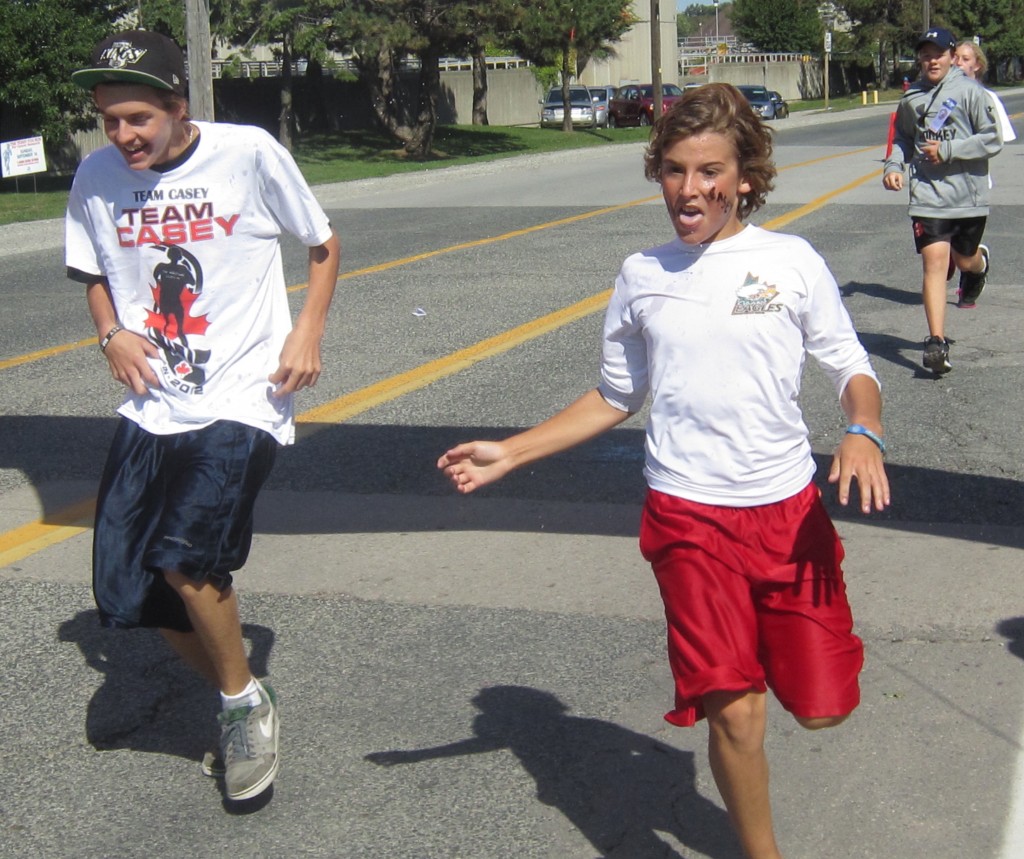 Two members of Team Casey giving it that final push. Casey Cosgrove has taught thousands how to deal with health adversity. Some disabled people are made to feel like failures if they haven’t done something extraordinary. Casey is just an ordinary guy doing his best and giving just as much as he is getting.
One of Fox’s earliest supporters was Isadore Sharp, founder of the Four Seasons Hotels. Sharp had lost his own son to cancer and offered Fox and his companions free accommodation at his hotels. He donated $10,000 and challenged 999 other businesses to do the same. Sharp also proposed an annual fundraising run in Fox’s name. Fox agreed, but insisted that the runs be non-competitive. There were to be no winners or losers, and anyone who participated could run, walk or ride. Sharp faced opposition to the project. The Cancer Society feared that a fall run would detract from its traditional April campaigns, while other charities believed that an additional fundraiser would leave less money for their causes. Sharp persisted, and he, the Four Seasons Hotels and the Fox family organized the first Terry Fox Run on September 13, 1981.
 Some members of Team Cosgrove made their own sweaters. One of those has to be used in the Spiral submission for the Performing arts Centre if that submission is chosen. Over 300,000 people took part and raised $3.5 million in the first Terry Fox Run. 4000 of those dollars came from Burlington.
Schools across Canada were urged to join the second run, held on September 19, 1982, and now have their own National School Run Day. The runs, which raised over $20 million in its first six years, grew into an international event as over one million people in 60 countries took part in 1999, raising $15 million that year alone.
Last Sunday, in Burlington, more than 1000 people did the run – and 200 of them were there for Casey Cosgrove and the COZ.
Part 1 of 4
Part 2 of 4
Part 3 of 4

|
|












































































































